SOUTHAMPTON TOWN’S 375th ANNIVERSARY
————————————————
Modern Era
1916 / 2018
_______________________________________________________
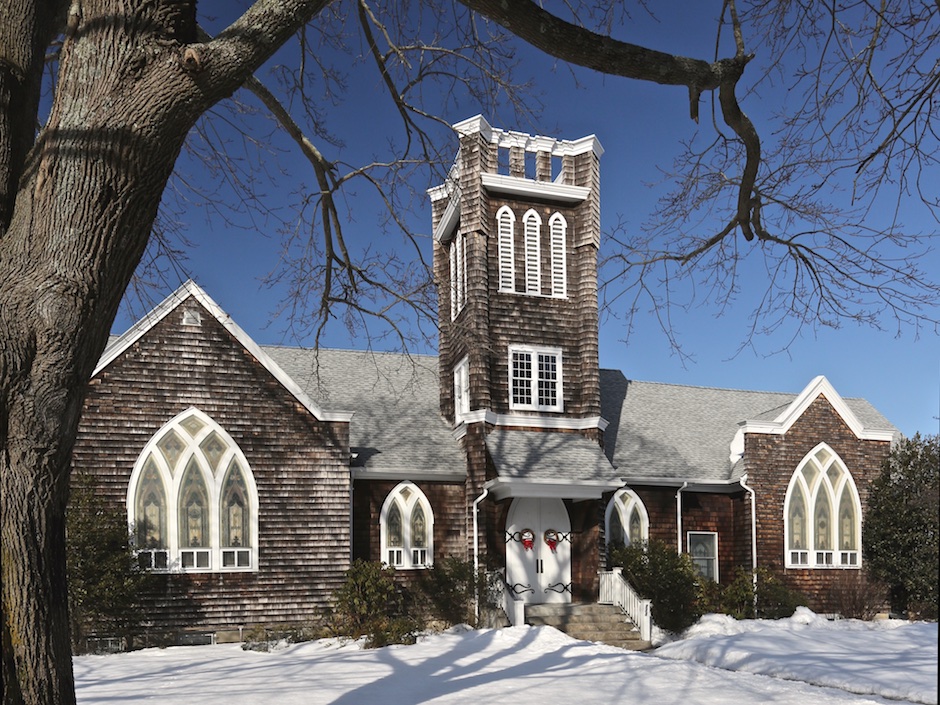
Methodist Church, 1919, Westhampton. Designed by Leonard L. Bishop.
The Westhampton Methodist Church was built after an earlier church burned in 1919. It was designed by Leonard L. Bishop. It is a shingle-clad example of a late Gothic Revival style. It features a castellated tower and pointed arch windows containing stained glass, some of which are Tiffany windows. — Town of Southampton.
_______________________________________
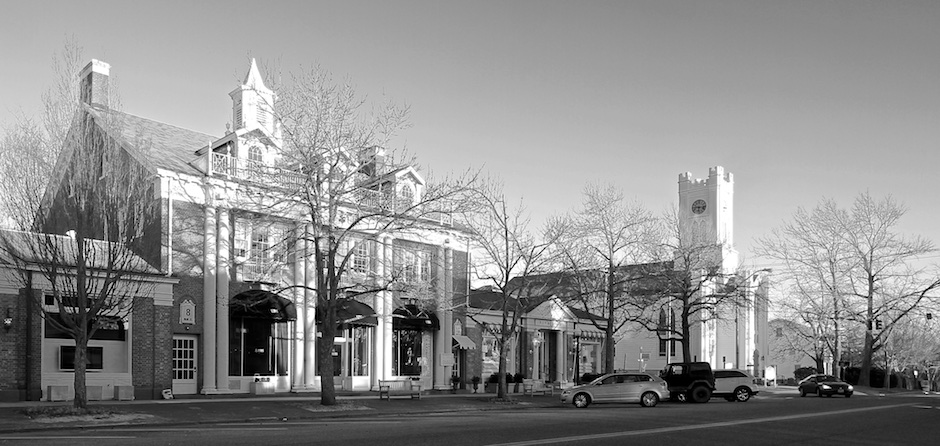
 Parrish Buildings, 1920s, Southampton with First Presbyterian Church in background. Grosvenor Atterbury, architect.
Parrish Buildings, 1920s, Southampton with First Presbyterian Church in background. Grosvenor Atterbury, architect.
The stately, brick two-story Colonial Revival building that faces Village Hall was constructed in stages in the 1920s by Samuel L. Parrish to the designs of architect Grosvenor Atterbury. Noted retailers such as Saks Fifth Avenue and Best & Co. have taken turns as tenants. The one-story extension to the north was the first built, followed by the central block made possible by moving the Parrish residence back from the street. As originally built, the central section was an open arcade giving access to the Rogers Mansion (Samuel L. Parrish, owner). — Southampton Historical Museum.
www.southamptonhistoricalmuseum.org
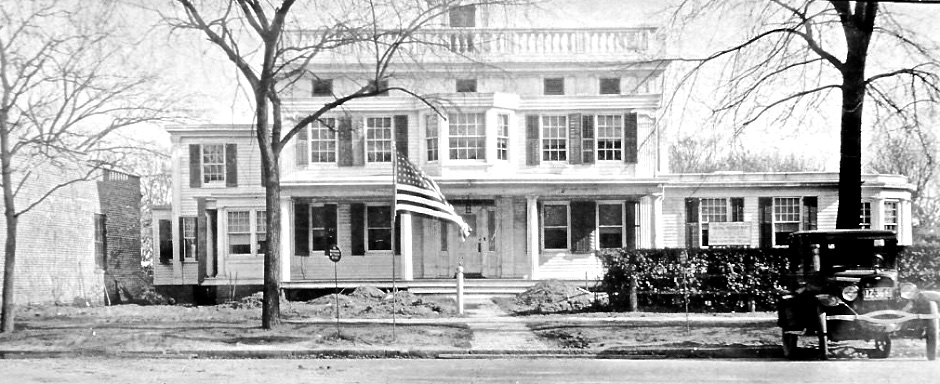
Parrish residence prior to move away from street to allow construction of the Parrish Buildings.

Parrish residence to the right, prior to construction of the Parrish Buildings. Corwith’s Pharmacy to the left. Archival photographs and postcard courtesy of Southampton Historical Museum.
_______________________________________
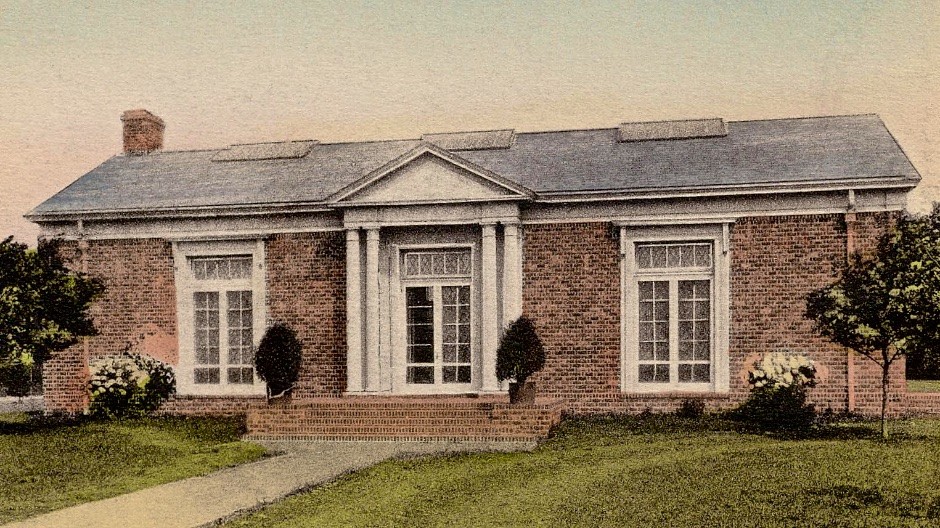
Parrish Memorial Hall, 1922, Southampton Village. Archival postcard courtesy of the Southampton Historical Museum.
Parrish Memorial Hall, the gift of Samuel L. Parrish, and built in 1922 in memory of the soldiers and sailors who perished during World War I. In the 1930s, it functioned as a summer theatre. — Historic Division, Southampton Town Clerk.
Historic Division, Southampton Town Clerk.
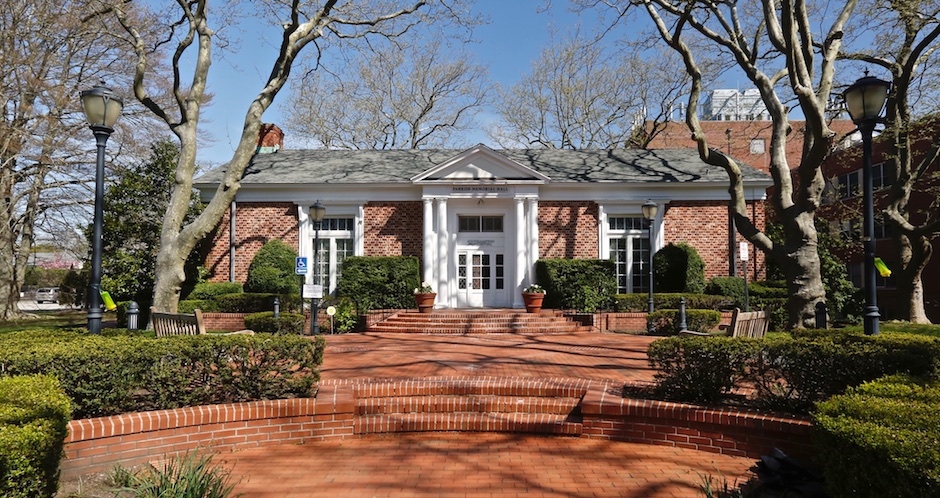
Parrish Memorial Hall, May 4, 2017
_______________________________________
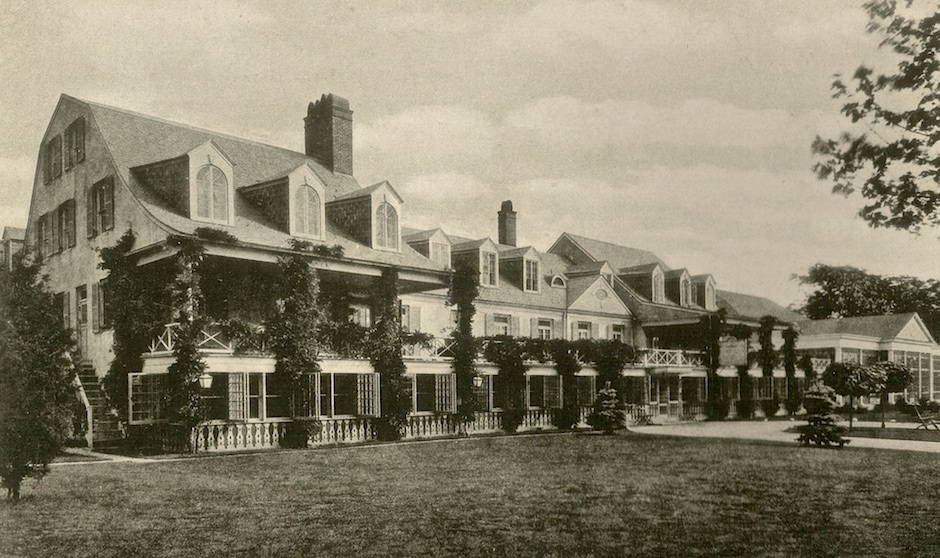
Canoe Place Inn, 1920s, Hampton Bays. William L. Bottomley, architect. Archival Postcard courtesy of the Southampton Historical Museum.
This abandoned complex of Dutch Colonial Revival style structures was originally known as the Canoe Place Inn. The inn took its name from a long line of successive structures by the name, the first established prior to the Revolution. The present version of the inn was constructed after an earlier structure burned down in 1921. Julius Keller rebuilt the structure in the Colonial Revival theme of the earlier structure. The architect was William L. Bottomley, also designer of Southampton Town Hall. The complex was a popular nightclub for many decades, though its business dwindled in the 1990s. It is now closed. — Town of Southampton.

Canoe Place Inn Ballroom, archival postcard courtesy of Eric Woodward.

Canoe Place Inn, May 26, 2015
_______________________________________

Southampton Beach & Tennis Club, 1923. Archival postcard courtesy of Eric Woodward.
The Southampton Beach & Tennis Club is said to be one of the most exclusive
on the East Coast. The stucco Spanish Revival style central pavilion is well planned for summer activities, with open arcades facing both the pool area and the ocean beach below. The dining room and adjoining kitchens occupy the main building. The architectural style suggests the warmth of the Mediterranean Sea, always a destination for cold Northern Europeans, and a popular choice in the 1920s for estate houses as well as related leisure destinations. —– Historic Division, Southampton Town Clerk.
Historic Division, Southampton Town Clerk
_______________________________________

The Bridgehampton Community House, ca. 1923.
The Bridgehampton Community House, a large, Classical Revival-style community house with two-story height entry portico, was constructed circa 1923. Construction of the Community House was instigated largely by local resident and author James Truslow Adams, and was constructed through the donations of local residents. The venue was used for movies, plays, dances, and other community events. — Town of Southampton.
_______________________________________

World War Memorial, built of Indiana limestone, Agawam Park, Southampton. Dedicated August 19, 1923. William Edgar Moran, Architect.
The World War Memorial consists of a platform slightly raised above its surroundings, the central portion three steps up and the side two steps. In the center has been erected a temple of simple Corinthian style with nautical trophies–the dolphin, the trident and the anchor–for ornament, as suggested by the ocean setting of this ancient village. The temple is roofed for shelter and on its interior walls are carved the names, rank and service of the Southampton men and boys who made the supreme sacrifice. Here are also carved the shields of the various allies and on the exterior great eagle panels with the shields of Great Britain and France. In the center, on a platform of stone, on which is cut compass points, stands a commemorative altar of victory carved with the symbolic oak and laurel supported by rods and capped by conventional tin hats.
Left and right of the temple, on encircling walls, there has been carved 325 names of those from Southampton who served under the colors. Through its open colonnade and two broad openings are seen Agawam Lake, dunes and distant ocean. — Southampton Press (article abridged), August 20, 1923.
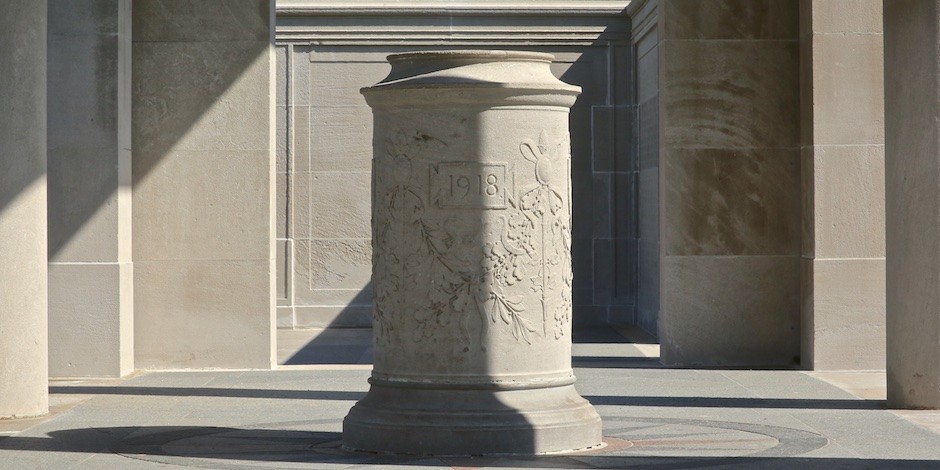

Illustration courtesy of the Southampton Historical Museum.
_______________________________________

Quogue Community Hall, 1924, later expanded. C.M. Carman, builder.
Work began on the Quogue Community Hall in 1922 and was completed in 1924. It
was built to accommodate public functions in the village, such as the showing of motion pictures. It came into being by the combined efforts of the Quogue Village Improvement Association and the Quogue Ladies’ Aid Society. It was constructed by builder C.M. Carman for about $15,000. — Historic Division, Southampton Town Clerk.
Historic Division, Southampton Town Clerk
_______________________________________
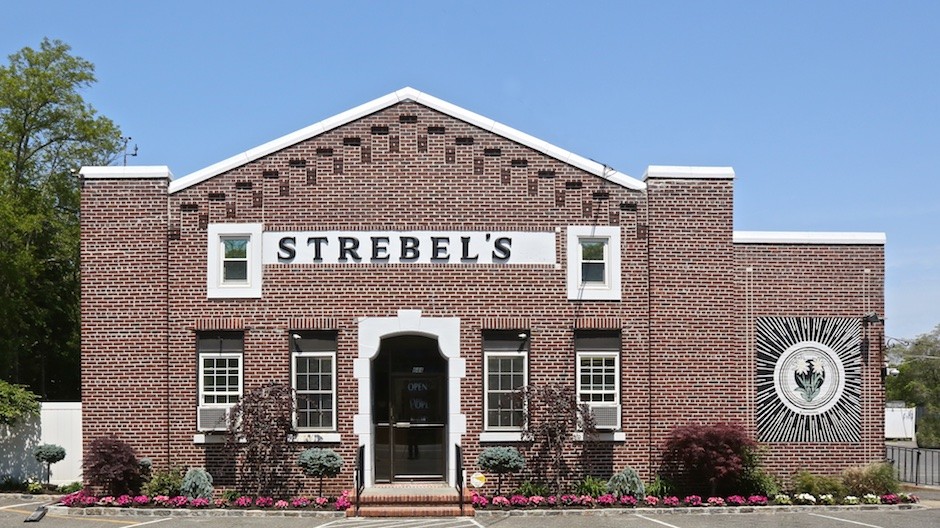
Strebel’s, ca. 1924, Westhampton
 This brick commercial building, constructed ca. 1924, is now called Strebel’s. The structure features a front gable with corbelled eaves treatment and a central doorway surrounded with a concrete or cast-stone surround. The windows appear to have been altered and the large sign on the front façade has likely changed, however, the building retains its character as an example of roadside commercial architecture of the 1920s. — Town of Southampton.
This brick commercial building, constructed ca. 1924, is now called Strebel’s. The structure features a front gable with corbelled eaves treatment and a central doorway surrounded with a concrete or cast-stone surround. The windows appear to have been altered and the large sign on the front façade has likely changed, however, the building retains its character as an example of roadside commercial architecture of the 1920s. — Town of Southampton.
_______________________________________
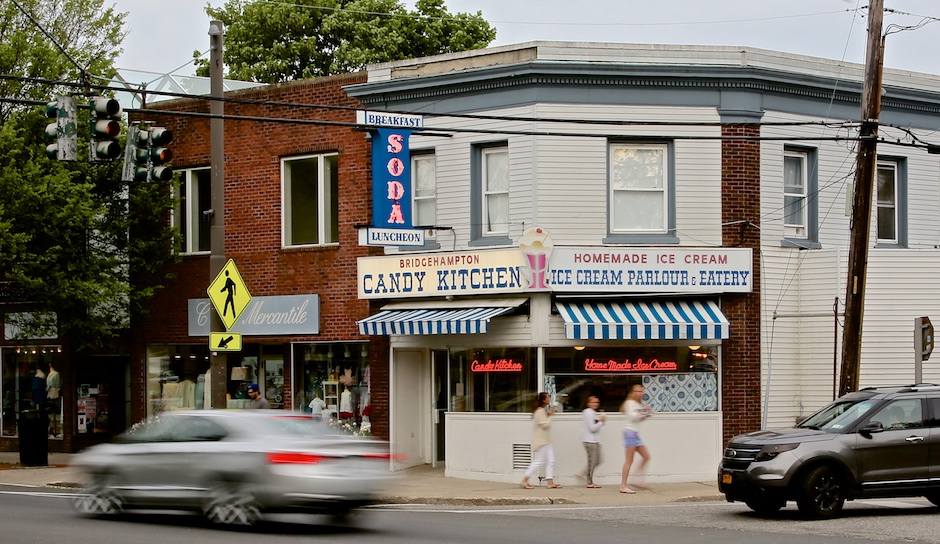
Bridgehampton Candy Kitchen, 1925.
Operated as the Candy Kitchen since it was constructed in 1925, this luncheonette and soda fountain is a two-story brick commercial building with a triangular plan and a chamfered entry bay. The original signage remains in place. — Town of Southampton.
_______________________________________
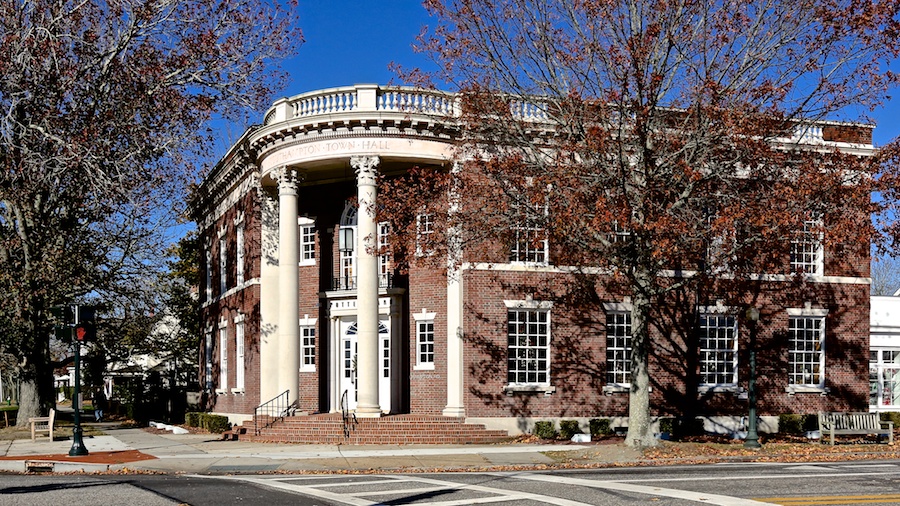
Southampton Town Hall, 1925. William F. LaFon, architect. Duryea & Baird builder.
Southampton Town Hall was dedicated on June 12, 1925. William A. LaFon was the architect; Duryea & Baird was the contractor and did the mason work. Constructions costs were $160,000. It has been converted for retail space. — Historic Division, Southampton Town Clerk.
Historic Division, Southampton Town Clerk
_______________________________________
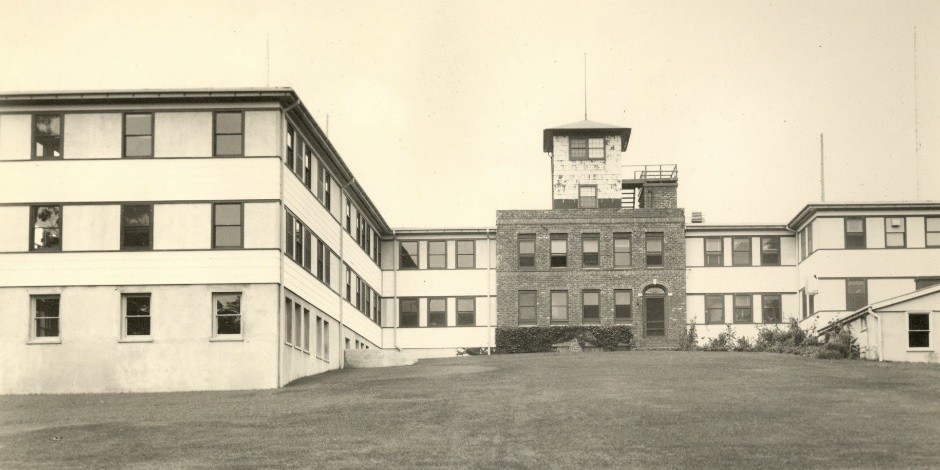 Western Union Laboratory. Archival photograph courtesy of the Southampton Historical Museum.
Western Union Laboratory. Archival photograph courtesy of the Southampton Historical Museum.
Western Union Laboratory, Water Mill, c. 1925 / 1965
For a brief period of time there was an experimental electronics laboratory in Water Mill on Water Mill-Towd Road…The history of the lab is tied to a member of the Corwih family, Howard P. Corwith, an electrical engineering graduate of Cornell University who went to work for Western Union in NYC after serving in WWI.…By 1925 he was working in Water Mill on weekdays too. Western Union had purchased a 22-acre tract of Corwith land and constructed a small brick research laboratory. The director of the lab was Howard Corwith.
The lab was initially used as a listening post to monitor the radio opertions of RCA and Mackay. But the electrical engineers who worked there went on to work on a number of projects, including ocean cable maintenance equipment, the concentrated arc lamp and a facsimile machine. During WWII two large wings were added to the original building for the manufature of military equipment, including an experimental night flight simulator. At the height of its activity, 75 people worked at the lab.
After the war, Western Union transferred the research to other facilities. The lab was phased out soon after the death of Corwith in 1962. — Water Mill: Celebrating Community
——————
The Watermill Center now occupies the site, opening in 2006, following extensive renovations & new construction. See below.
_______________________________________
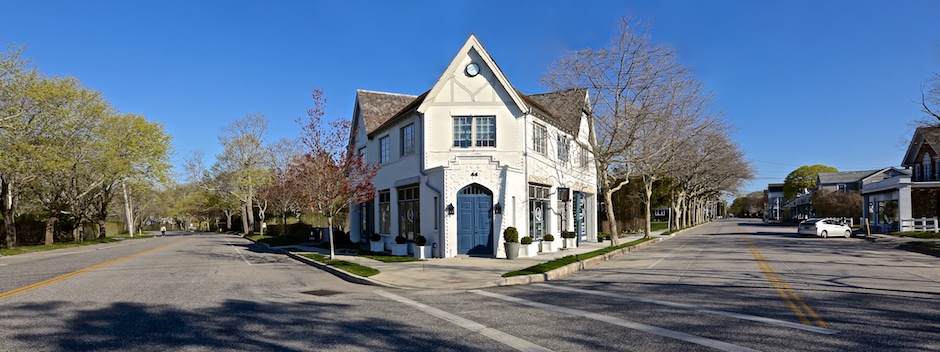
Carmen Building (original building 1928), Quogue, corner of Jessup Avenue and Quogue Street. Austin Patterson Disston Architects, second floor addition, renovation.
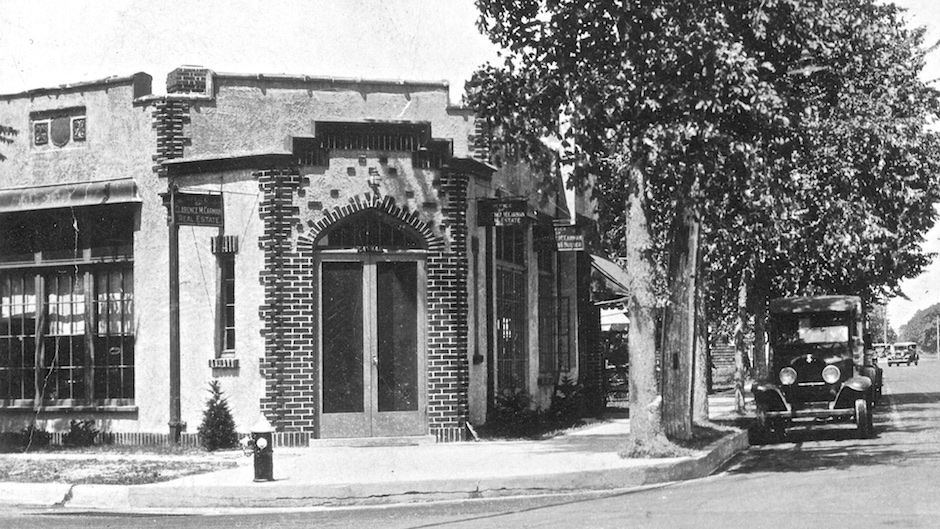
Clarence Carmen Building, 1940, Quogue. Archival photo courtesy of the Quogue Historical Society.
_______________________________________
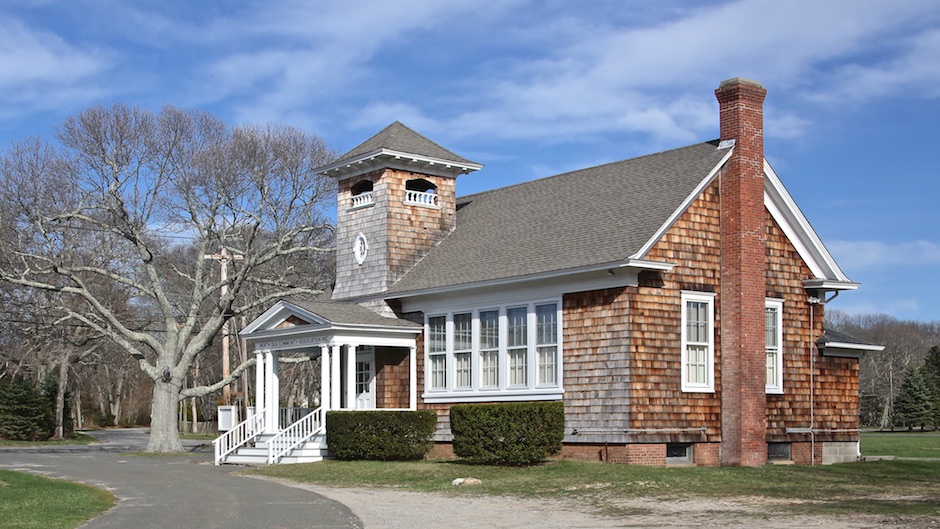
North Sea Community Association, 1929.
The North Sea Community Association is a shingle-clad building, constructed in 1929 as a school and used as a meeting place for the Community Association since 1933. The structure has a prominent tower with a pyramidal roof with overhanging eaves and exposed rafter ends. The doorway is accessed by a pedimented entry porch supported by paired columns. Ribbon windows are located along the facades. — Town of Southampton.
_______________________________________
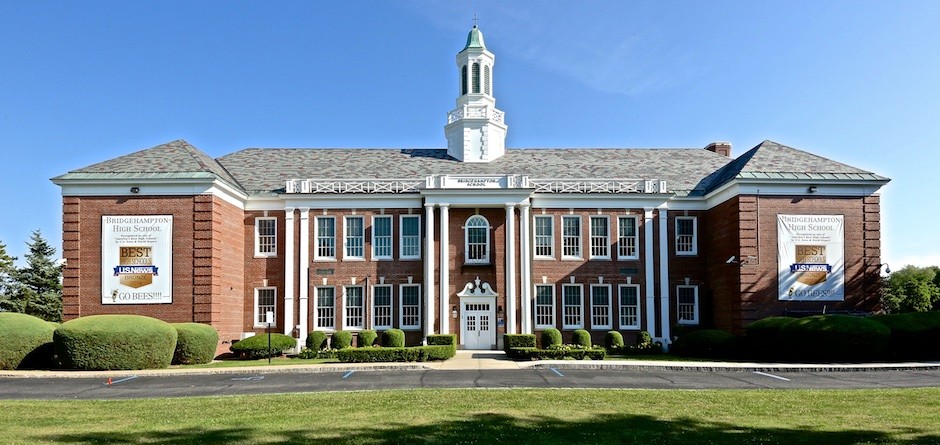
Bridgehampton Union Free School, 1930. Tooker & Marsh, Architects.
The Bridgehampton Union Free School is a Colonial Revival-style structure which was completed in 1930. The building houses kindergarten through 12th grade classes. The two-story H-plan brick building, reportedly designed by the New York firm Tooker & Marsh, has a tripartite façade which centers on an entry bay flanked by paired full-height columns. The doorway is distinguished by an elaborate Colonial Revival-style door surround, likely rendered in cast stone. It is surmounted by a round-arch window. All of the windows throughout the structure have simple surrounds with pronounced cast stone keystones. The structure has a hipped roof clad in slate and surrounded by a low parapet. The roof is surmounted by a cupola. — Town of Southampton.
_______________________________________

Saint Mary’s Episcopal Church, 1919 / 1931, Hampton Bays
Saint Mary’s Episcopal Church is fine example of the Tudor Revival/Medieval Revival style. It is composed of several sections, all parged with stucco applied with a rusticated treatment to suggest the presence of masonry beneath it. Two separate sections with steeply pitched gable roofs are connected to a square-plan crenellated tower via a Norman-arch arcade with buttresses. Griffin-like gargoyles decorate the corners of the tower. A wood frieze panel with a decorative carving of a series of figures evokes the Medieval. Narrow windows adorn the apex of the gables. The windows throughout the structure contain multi-light leaded casement sash and are framed with rustic wood frames. The building was constructed in stages between 1919 and 1931. — Town of Southampton.
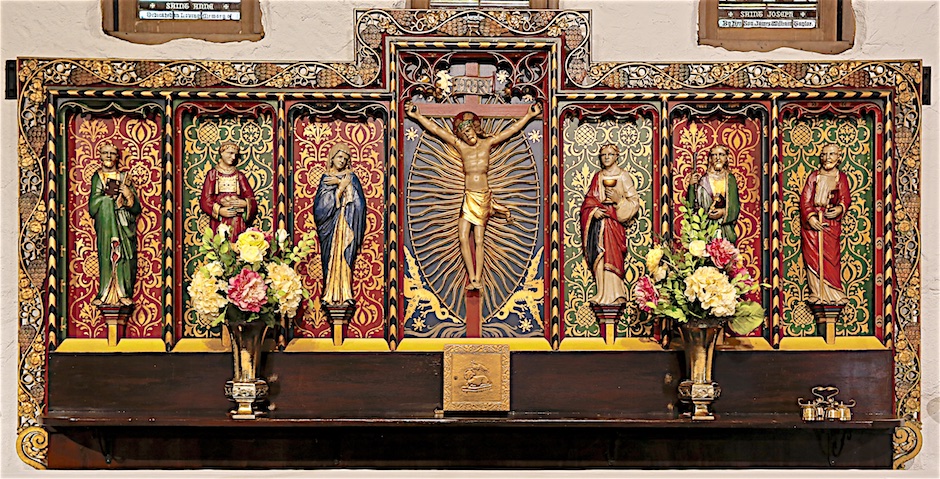
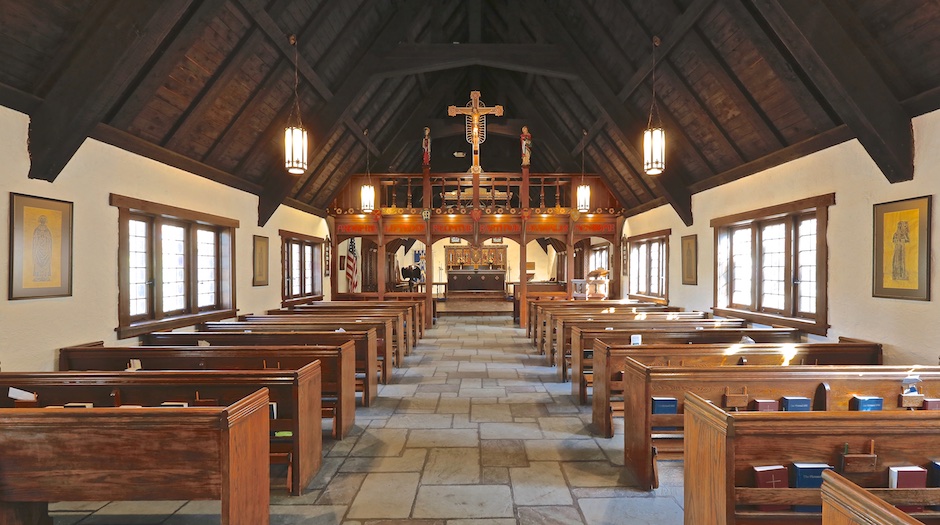
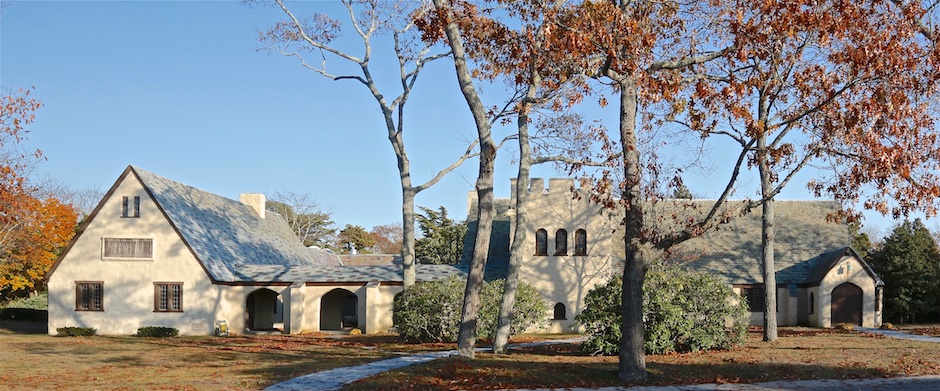
_______________________________________

LIRR Bridge over Shinnecock Canal, 1931, Hampton Bays
Prior to this bridge’s construction in 1931, earlier railroad bridges carried the Long Island Railroad across the Shinnecock Canal in this location since the time of the railroad’s inception in this area. The “K4 bridge,” heavier than its predecessors, was installed in June 1931 over Shinnecock Canal allowing new larger models of trains (including the K4) to pass safely over the canal. The steel truss bridge is supported by large granite piers. — Town of Southampton.
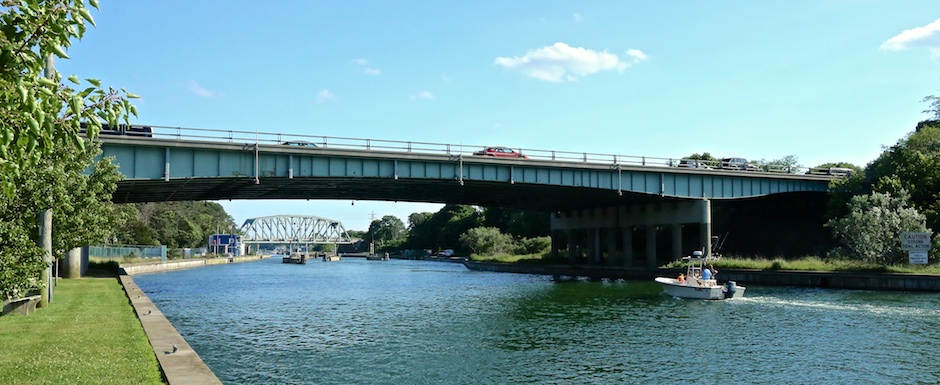
Shinnecock Canal with Sunrise Highway, foreground, LIRR Bridge in distance.
_______________________________________
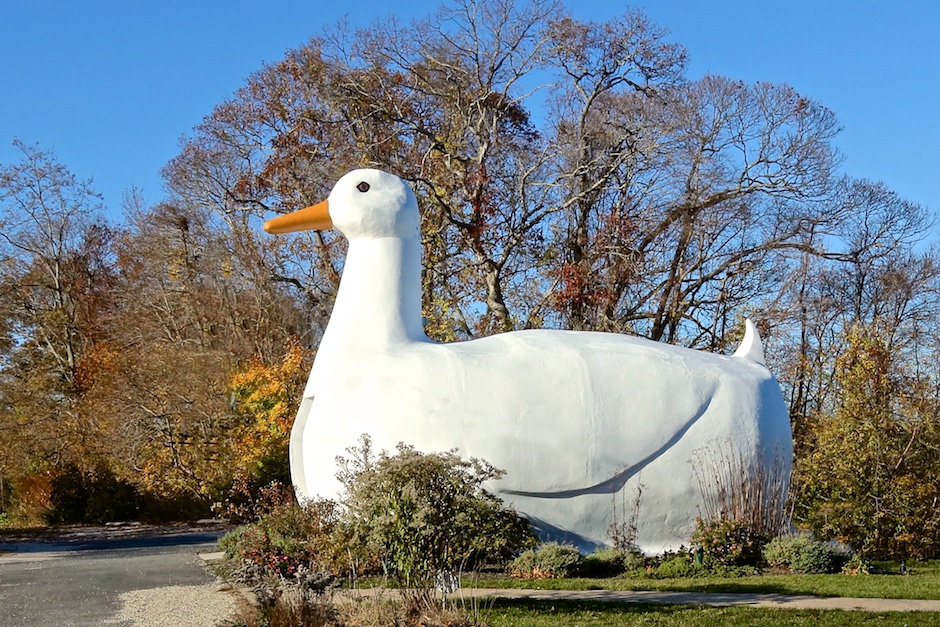

Big Duck Ranch, 1931, Flanders. Big Duck designed & built by Martin Mauer.
The Big Duck was constructed in 1931 to serve as a salesroom for Long Island Peking Duck meat. It is constructed of a wood frame covered in concrete using a wire mesh substrate. The Big Duck measures roughly 30 feet long by 20 feet high. From 1936 to 1984, this was the duck farm of Martin Mauer, the man who conceived the idea for the Big Duck and its original owner. The Big Duck is a famous example of early roadside architecture. It is now used as a tourist center and gift shop that sells duck memorabilia. A non-profit group, “Friends of the Big Duck,” sponsors various events during the year to raise funds to maintain the gardens near the Big Duck and make improvements to the surrounding property known as the “Big Duck Ranch.”
New York State and National Registers of Historic Places.
Southampton Town Landmark — Big Duck Ranch.
Visit Friends of the Big Duck at www.bigduck.org
——————————-
The Big Duck at its temporary location in Hampton Bays.
World Famous Duck Architecture
While The Big Duck is a well-known Long Island landmark, it has also lent its name to a specific style of roadside architecture. The architectural term “duck” was coined by architects Robert Venturi and Denise Scott Brown in 1968. Duck buildings are highly sculptural forms which represent products or services available within, as opposed to the more common “decorated sheds” which are plain buildings whose functions are revealed by added signage. With Suffolk County’s Big Duck, as with other architectural ducks, the building itself is the signage, a colossal, three-dimensional, representational advertisement. Designed to mesmerize passing motorists and entice them ultimately to a purchase, ducks are fantastical while retaining their purely practical intentions. The Big Duck has become the most famous example of roadside architecture. — Suffolk County Parks.
_______________________________________

Tower Gallery, 1937, Southampton. B. Robert Swartburg, architect.
The Southampton Shops at the corner of Jobs Lane and Main Street were introduced in
1937 as “modern store building(s) designed for the occupancy of high class shops catering to the discerning purchaser and providing (a) shopping accommodation for the large summer colony that makes Southampton its headquarters.” The four-story brick corner tower, fortress-like beneath a conical slate roof, strikes a visual balance with the Rogers Memorial Library across the street, while fluted columns supporting arched entryways establish a rhythm along Jobs Lane. Bonwit Teller, an upscale department store founded in 1895 and liquidated in 1990, occupied the corner store in 1937. — Southampton Historical Museum.
Archival photograph courtesy of the Southampton Historical Museum.
www.southamptonhistoricalmuseum.org
_______________________________________
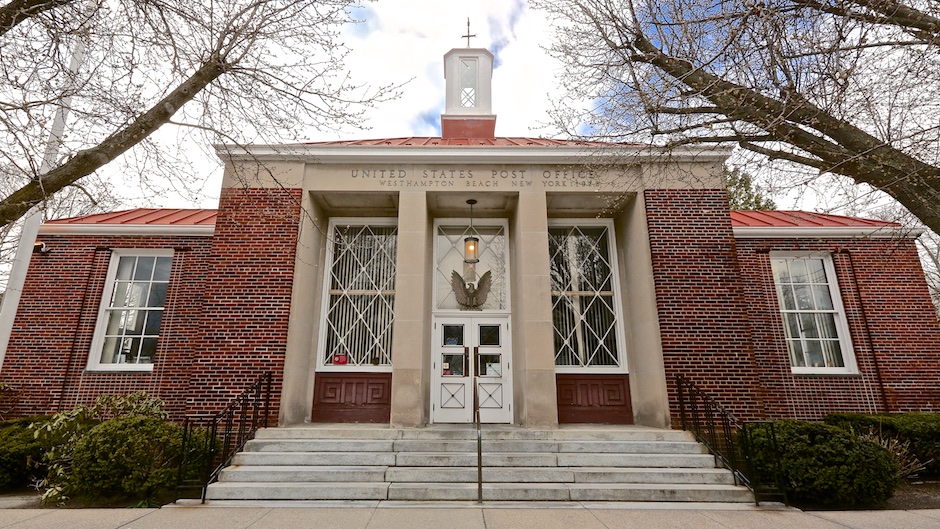
United States Post Office, 1940, Westhampton Beach. Louis A. Simon, Architect (Supervising Architect of the Treasury Department)
This building, which is listed on the National Register of Historic Places, was designed by Louis A. Simon, Supervising Architect of the Treasury Department, and is an intact example of federal architecture initiated by the U.S. government during the Great Depression of the 1930s. Completed in 1940, the building was designed in an austere version of the Colonial Revival style, with simplified classical forms. Of interest, inside to the right of the entry is a mural entitled “Outdoor Sports” painted by Sol Wilson in 1942. Mr. Wilson emigrated from Poland in 1911 and painted for the U.S. Treasury Department’s Section of Fine Arts. — Westhampton Beach Historical Society.
National Register of Historic Places.
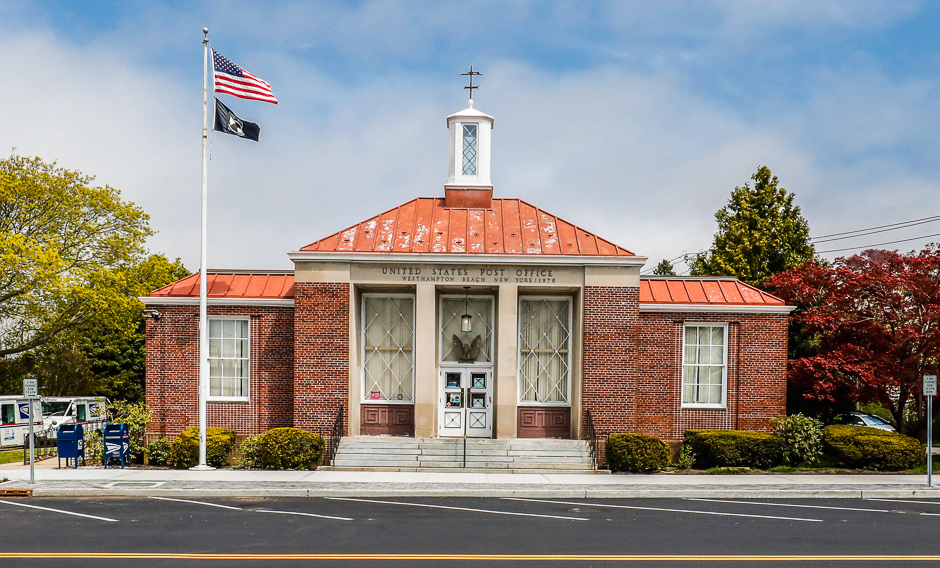
May 3, 2020
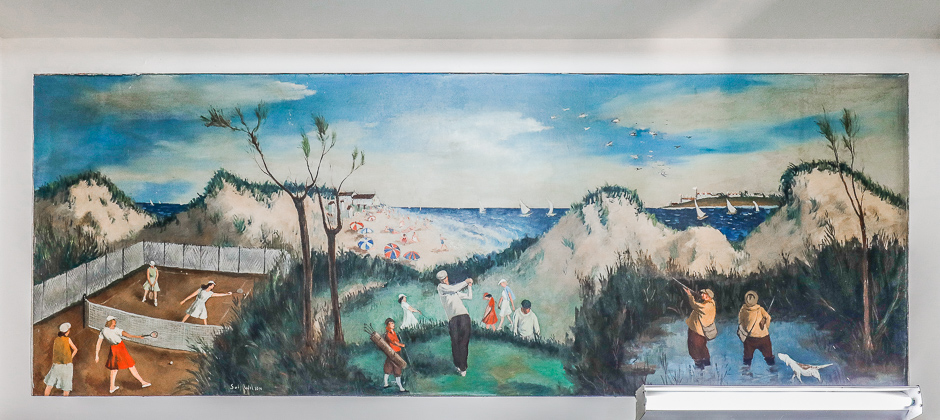
“Outdoor Sports” by Sol Wilson, 1942, in the Westhampton Beach Post Office lobby.
_______________________________________

Zabrowski Potato Barn, Water Mill, 1946.
This structure is a large concrete potato barn with buttresses along each elevation and vents along the roof ridge. It has a brick chimney at one end and a small window in the gable. The barn is a fine example of its function type, which is significant for its association with local agricultural history. It was built in 1946 for Julian Zabrowski. — Town of Southampton.
_______________________________________

Hampton Arts Theater, 1947, Westhampton Beach.
Formerly the Hampton Star Theater (also known as the Westhampton Playhouse), it was constructed in 1927 by Harry Nugent and burned in 1932, unfortunately without fire insurance. It was rebuilt by Mr. Nugent and reopened in 1947. The original building included not only a theater, but the first Westhampton Beach Village office and a candy and ice cream business. Although the theater space has been divided, it remains an active movie venue. —– Westhampton Beach Historical Society.
_______________________________________

Architect Peter Blake’s Pinwheel House, 1954, Water Mill
A mid-20th century modern house with a boxlike form and extensive use of glass, this residence was designed by architect Peter Blake. — Town of Southampton.

Renovation & Expansion by Stelle Architects.
_______________________________________

Elizabeth A. Morton National Wildlife Refuge, 1954, Noyac. 187 acres.
The Elizabeth Alexandra Morton National Wildlife Refuge plays an important part in providing not only resting and feeding areas for waterfowl, but also a wilderness area for the public to enjoy. In addition to the sanctuary afforded waterfowl and other birds and animals, the surrounding bays are filled with scaup, goldeneyes, buffleheads, oldsquaws, and scoters during the fall and winter months. The property was donated to the U.S. Fish and Wildlife Service in 1954 by Mrs. Elizabeth Alexandra Morton Tilton. It is one of the few remaining natural areas located on the interior bays.
www.fws.gov/refuge/elizabeth_a_morton/
_______________________________________
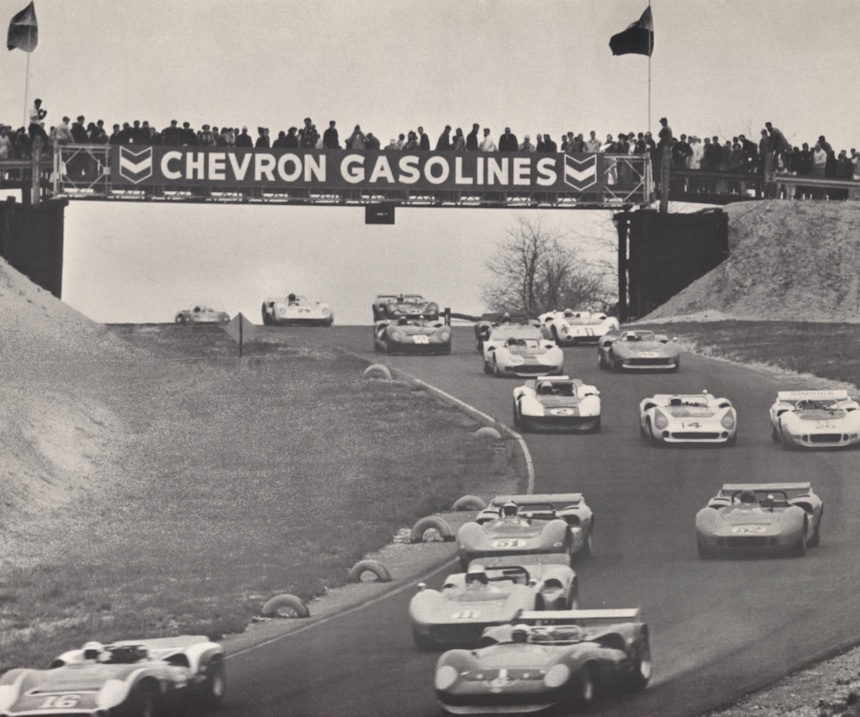
Bridgehampton Race Circuit, 1957 / 1971.

Historic Structure, The Bridge Golf Club, June, 2015.
_______________________________________
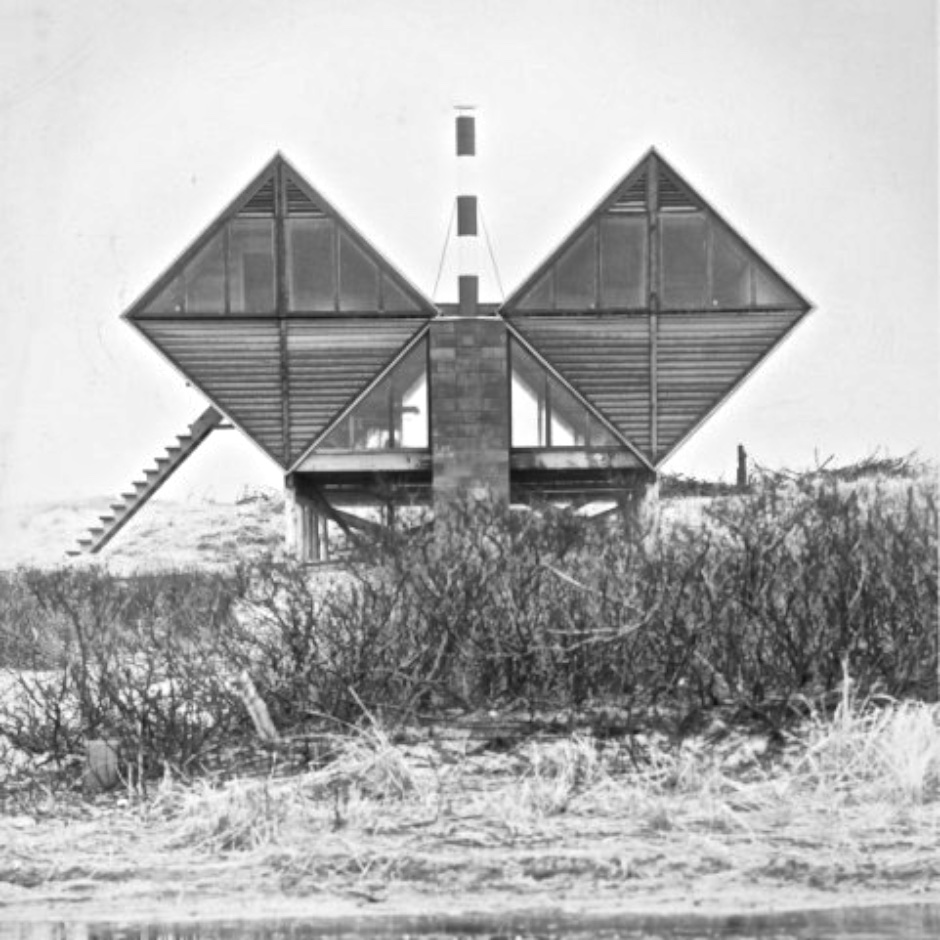
Pearlroth House, 1959, Westhampton Beach. Andrew Geller, designer.
_______________________________________

Incarnation Lutheran Church, 1961, Bridgehampton
The Incarnation Lutheran Church has an almost ship-like design, and is clad largely by wood boards applied vertically and diagonally. It was constructed in 1961. The unusual building was designed by the Murphy Company. Prefabricated components were shipped from Urbana, Illinois, then assembled by crane on the site. — Town of Southampton.
______________________________________________

House, 1967, Water Mill. Alfred Scheffer, architect.
A client, Thomas Griffith, wrote an insightful estimation of the architect: “Interiors were his pride; his own taste ran to cleanliness, natural materials, and simplicity. He loved wood and old brick, so most of his work, though not an imitation of the East End style, fitted beautifully in with it.” (East Hampton Star, August 26, 1976) — Robert Hefner, Alfred Scheffer’s Beach Hampton Houses, 1941 to 1965 / Hampton Lane Press.
AAQ / Resource / Books — Click Here.
______________________________________________
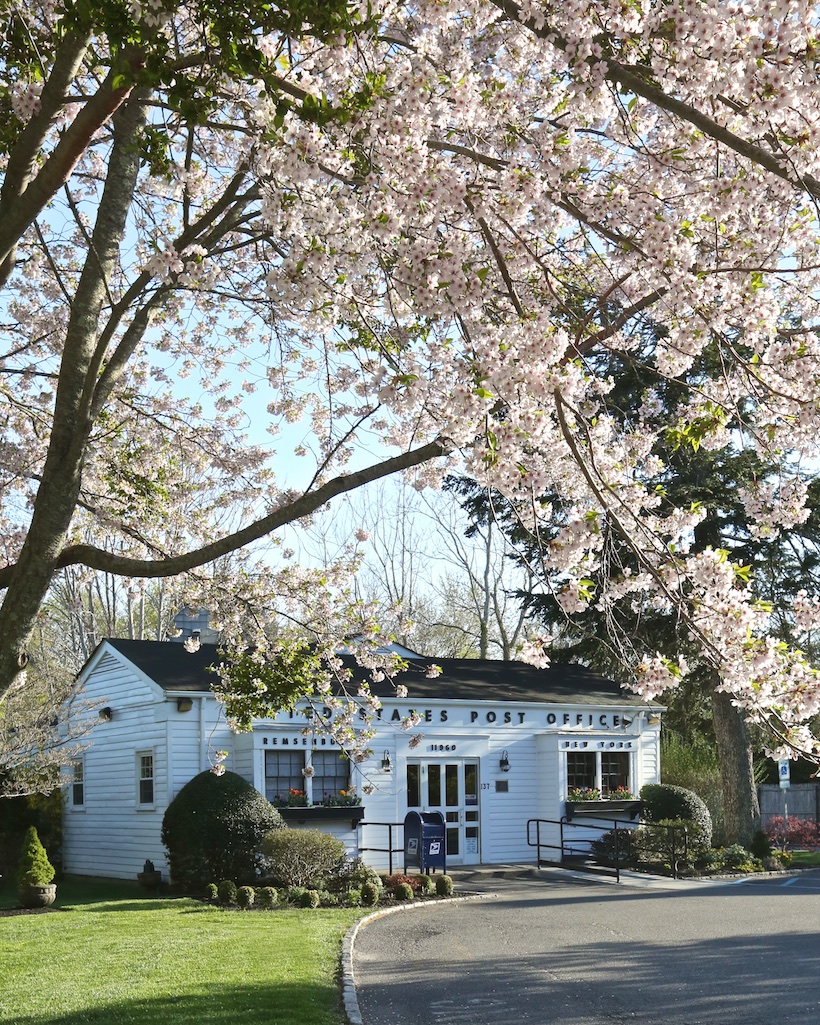
Remsenburg Post Office, 1969. Albert W. Butt, Jr., architect.
The Remsenburg Post Office is a mid-20th century building, a single story in height, divided into three bays. The central bay is occupied by a large doorway; this is flanked by bays containing projecting bay windows. — Town of Southampton.
_______________________________________
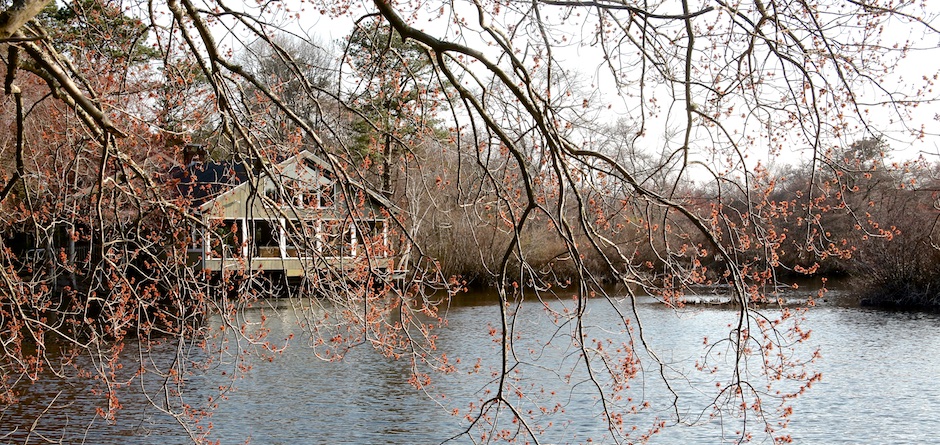
Charles Banks Belt Nature Center, 1970, Ice Pond, Quogue Wildlife Refuge. Esther Baird, designer.
The Quogue Wildlife Refuge is a 305-acre expanse of protected land, with more than seven miles of trails that include a variety of habitats such as Pine Barrens, bogs, wetlands, a field, and a tidal estuary. Its mission is to serve as a responsible land steward of the Refuge property and its natural resources, while promoting, implementing and supporting environmental education. — Quogue Wildlife Refuge.
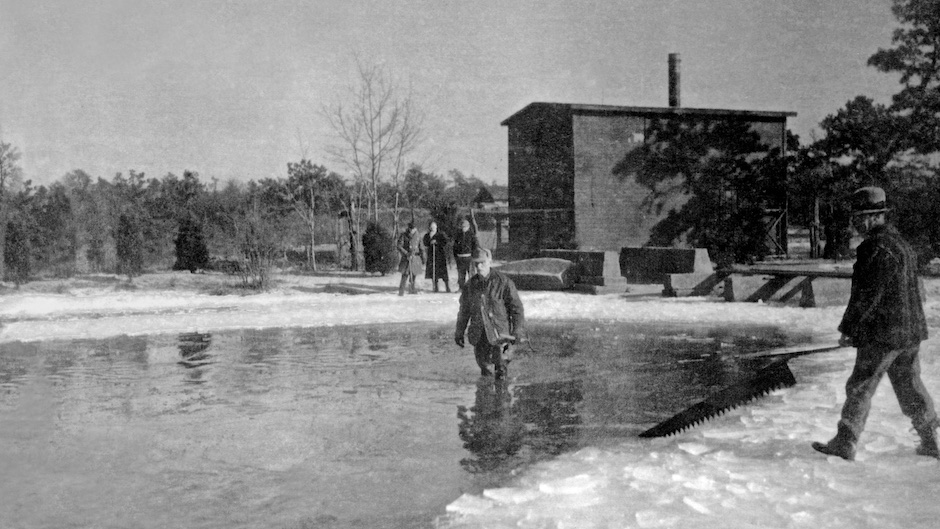
Ice House of the Quogue Ice Company, established 1913. The Ice Company constructed an earthen dam parallel to Quantock Creek to create the 10-acre Ice Pond. Archival photograph courtesy of the Quogue Wildlife Refuge.

_______________________________________
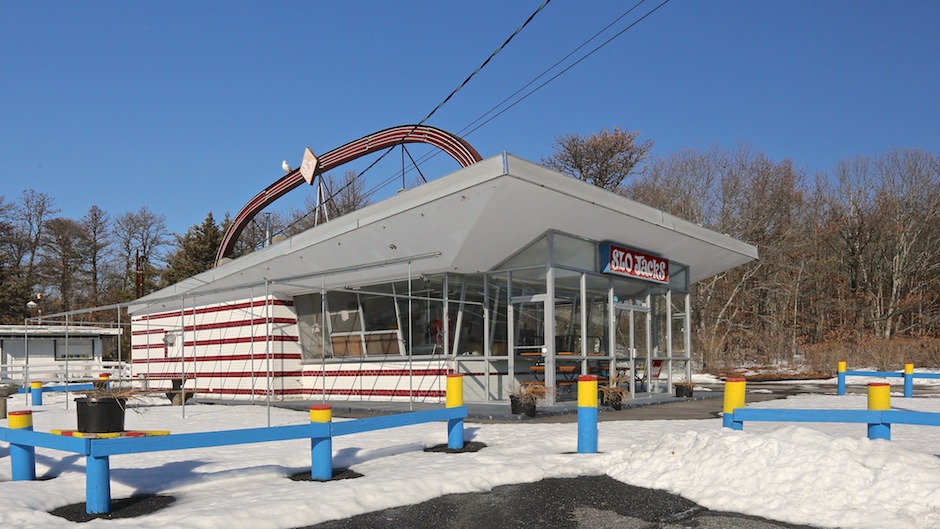
Slo Jacks Restaurant, Hampton Bays.
Slo Jacks restaurant is an unusual example of Art Deco roadside architecture. Despite the glass entry porch, which appears to be ca. 1970s addition, Slo Jacks appears to be a relatively intact example of early fast food architecture with a unique and dynamic design. The restaurant is constructed of metal, concrete and glass. A sloping flat roof is surmounted by two large arches imparting a space-age quality to the design. The windows at the front of the restaurant cant outwards at the top. The side facades are given a red and white horizontal striated finish treatment. According to the current owners, Slo Jacks has been in this building for over 30 years. Prior to that time, the structure housed a restaurant called Bays Burgers. — Town of Southampton.
_______________________________________

Crooked Pond, Long Pond Greenbelt Nature Preserve, 1975
The Long Pond Greenbelt Nature Preserve, widely recognized as one of the most ecologically significant areas in all of New York State, extends from Sag Harbor through Bridgehampton to Sagaponack. It features a chain of rare coastal plain ponds, assorted wetlands, woodlands, freshwater swamps and an extensive network of trails. The coastal plain ponds and pond shores support one of the highest recorded concentrations of rare and endangered species in the state. Since 1975, more than 800 acres have been preserved by Suffolk County, the Town of Southampton, and The Nature Conservancy to protect the Greenbelt’s rare and beautiful natural communities. — Sign at Preserve.
_______________________________________

Oceanfront, 1977, Southampton. Norman Jaffe, Architect.
_______________________________________
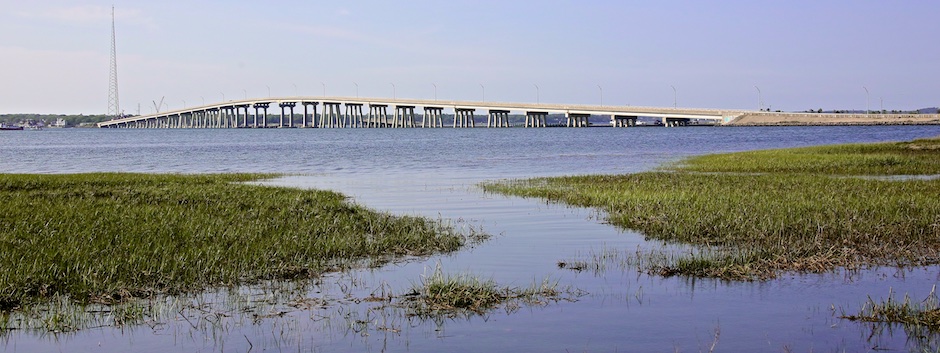
Ponquogue Bridge, Shinnecock Bay, Hampton Bays, 1986.

_______________________________________

Duck Walk Vineyards (originally Le Reve Winery), 1987, Southampton.
Established by Alan Barr in 1987, this Normandy Chateau-style building, has a copper roof and bricks imported from Mexico. Now the Duck Walk Vineyard, part of the 56-acre site was once where ‘ducks walked’ from the neighboring (to the west) duck farm in the 1930s and 40s.
— Duck Walk Vineyards.
_______________________________________
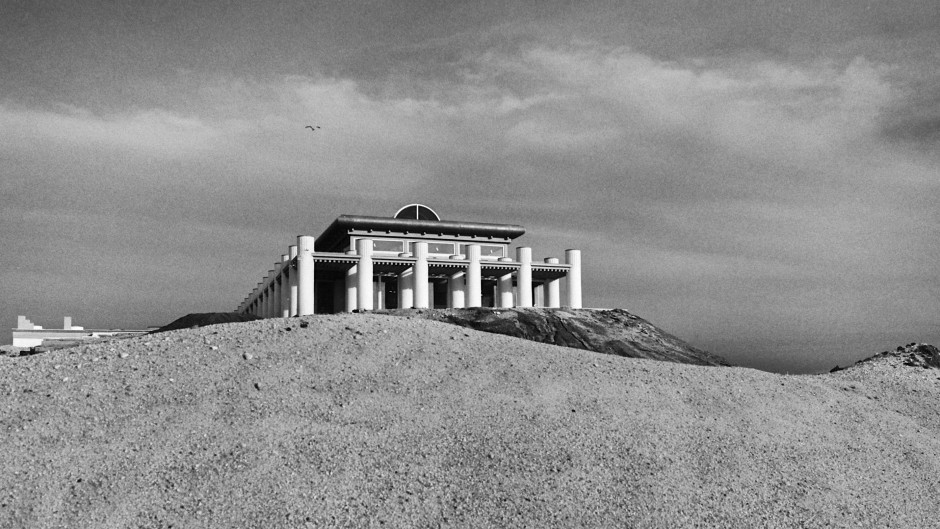
Oceanfront, 1989. Norman Jaffe, architect.
_______________________________________
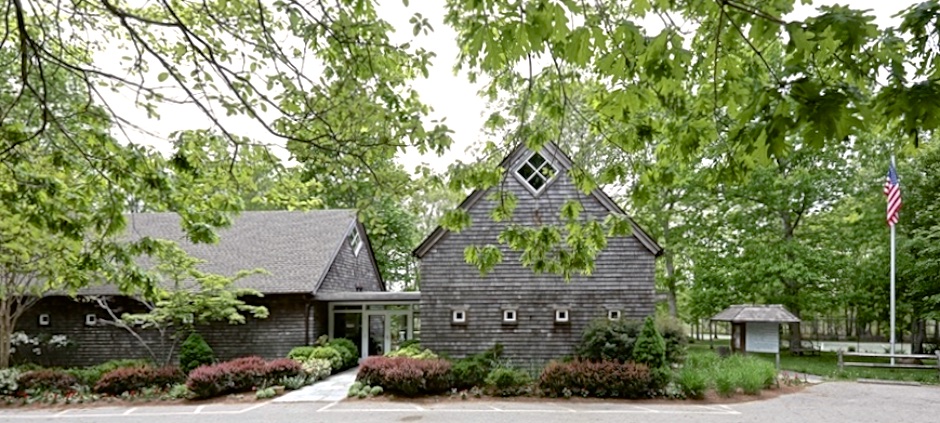
North Haven Village Hall, 1990. Stelle Architects.
The modest, one-story shingle-clad structure befits its wooded setting, and is organized around two sections connected by a glass-enclosed breezeway. — Historic Division, Southampton Town Clerk.
Historic Division, Southampton Town Clerk
——————————-
AAQ Resource: Stelle Lomont Rouhani Architects
_______________________________________
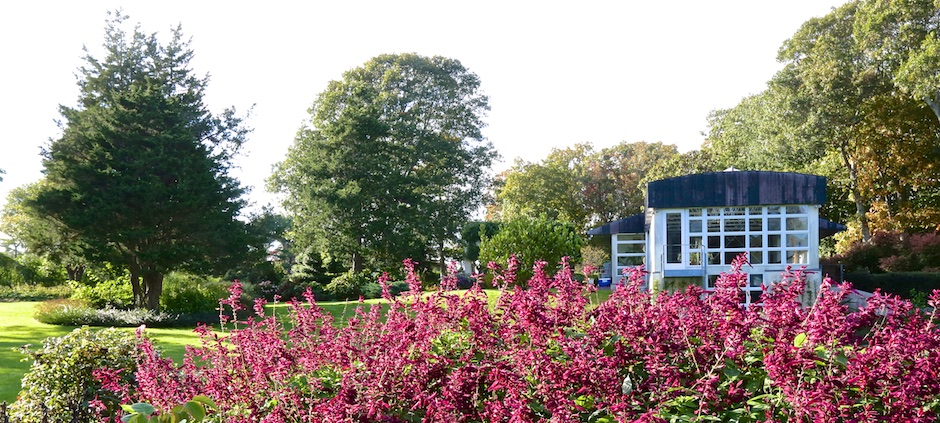
Bridge Gardens, Bridgehampton, 1992. Stephen Levine, Architect.

A unique public garden in the heart of Bridgehampton, Bridge Gardens was donated to the Peconic Land Trust in the fall of 2008 by founders and horticulturalists Jim Kilpatric and Harry Neyens. Kilpatric and Neyens began designing and installing the gardens in 1988, and over the ensuing 20 years created a wonderful oasis that spans over five acres and includes many specimens of trees, shrubs, hedgerow, roses, perennials and herbs. — Courtesy of the Peconic Land Trust.
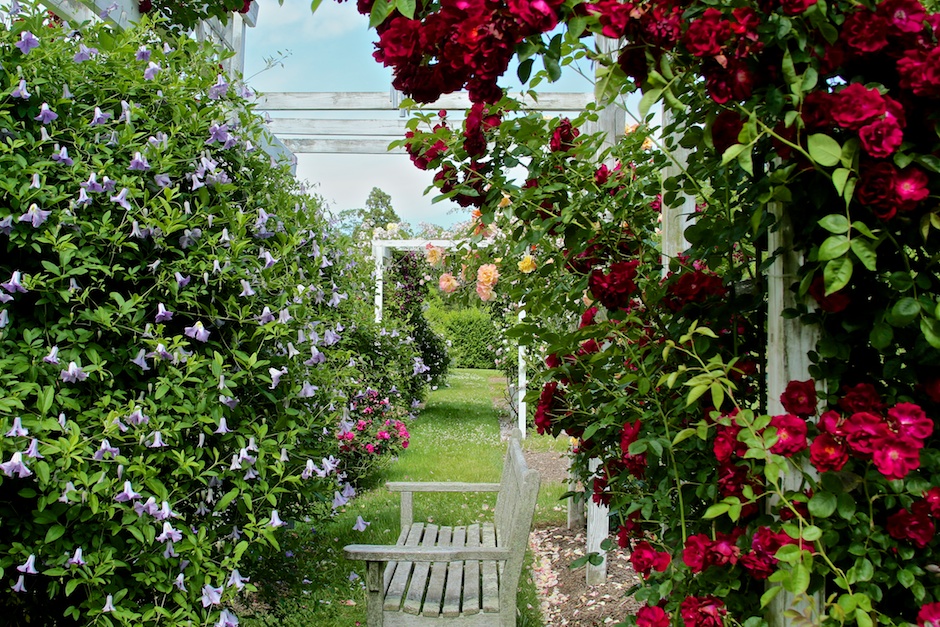
_______________________________________
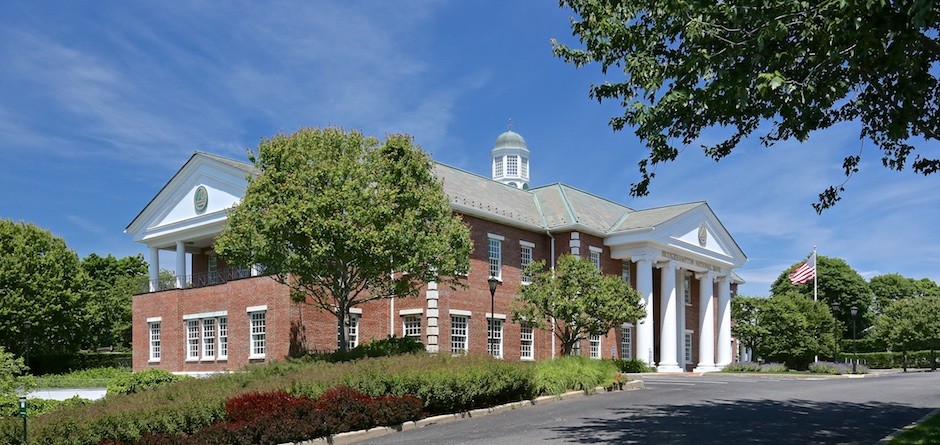
Bridgehampton National Bank (founded 1910), 1997. Wayne Architects; Tom McCarthy, builder.
_______________________________________
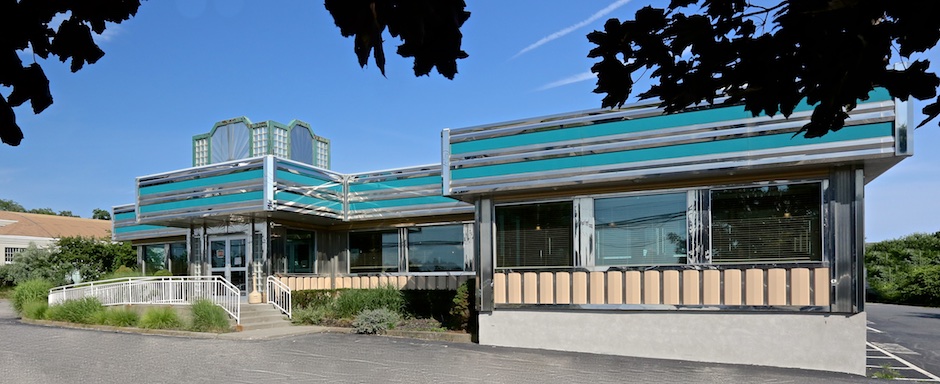
Princess Diner, 1998 (established 1964), Southampton. Designed & built by DeRaffele Mfg. Co., New Rochelle.
_______________________________________
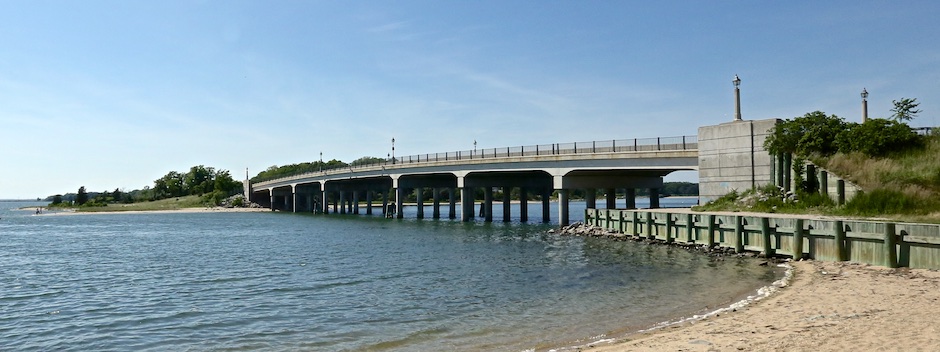
Lance Corporal Jordan Christian Hearter Veterans’ Memorial Bridge, Ferry Road, 2000, Sag Harbor
Lance Corporal Hearter (1988-2008) was a rifleman from the 1st Battalion, 9th Marines, who died at the age of nineteen while defending a checkpoint in Ramadi, Iraq, during the Iraq War in Anbar Province. His heroism and sacrifice is credited with saving the lives of over fifty marines and Iraqi policemen. Lance Corporal Hearter was awarded a Navy Cross and a Purple Heart for his bravery and is buried in Oakwood Cemetery. The bridge itself was built in 2000 and replaces an earlier span constructed in 1937. — Historic Division, Southampton Town Clerk.
Historic Division, Southampton Town Clerk.
_______________________________________
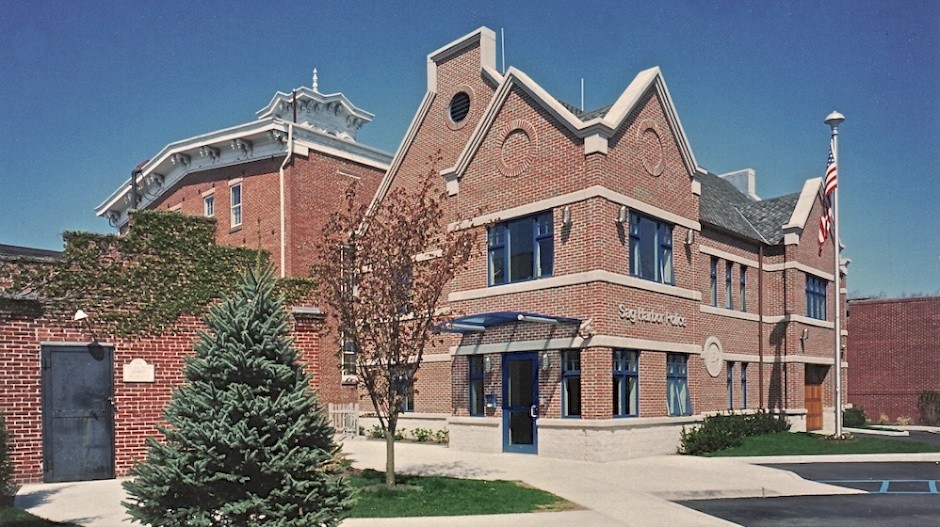
Sag Harbor Police Station, 2004. Flynn-Stott Architects. Municipal Building in background, Old Jailhouse Museum to the left.
Municipal Building, formerly the Mansion House Hotel: In 1873 the hotel was converted for use as Sag Harbor’s first comprehensive Union School. It functioned as a school until 1907, when philanthropist and summer resident Mrs. Russell Sage decided that a more modern school was needed. Pierson High School was built with her money the following year.
Old Jailhouse Museum: Restored in 1996 and operated as a museum by the Sag Harbor Historical Society, the Old Jail House was constructed in 1916 and intended to house prisoners more humanely than had been the case beforehand in the village. The museum displays a collection of police memorabilia and is open by appointment by calling the Sag Harbor Historical Society. — Historic Division, Town of Southampton.
www.sagharborhistoricalsociety.org
_______________________________________

Writing With Light House, 2004, Water Mill. Steven Holl Architects. Koral Bros. builders.
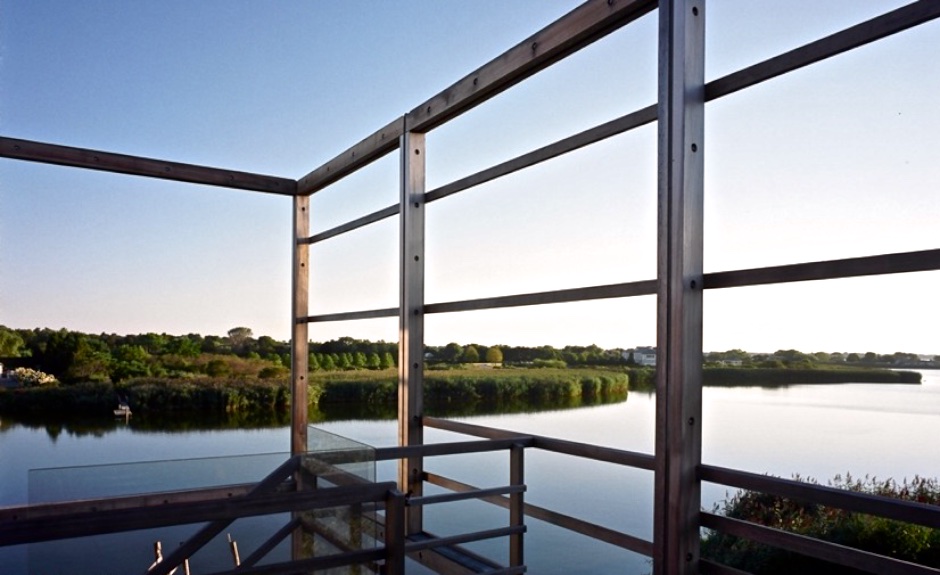
_______________________________________
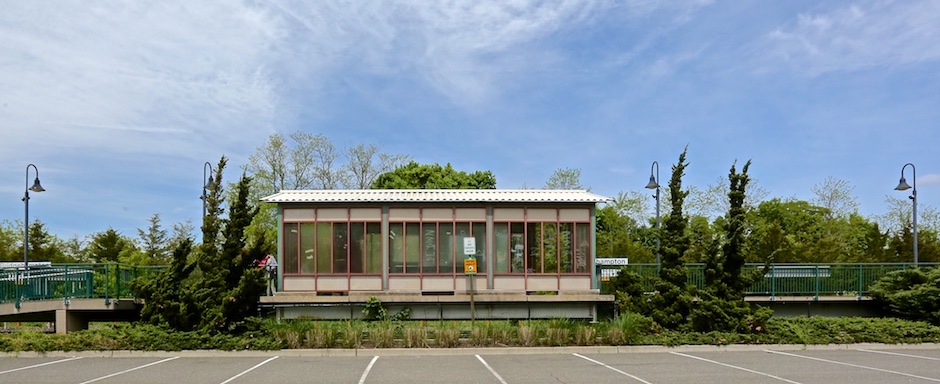
Bridgehampton Train Station
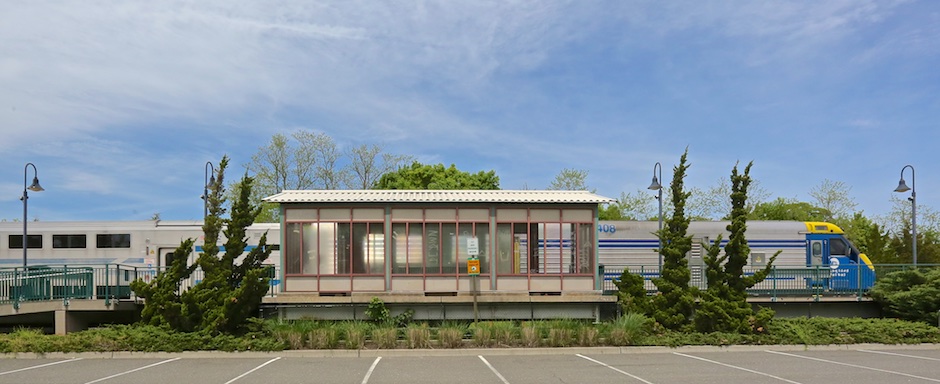
_______________________________________

South Fork Natural History Museum (SoFo), 2005. Rogers Marvel Architects. Quennell Rothschild & Partners, Landscape Architects.
The mission of the South Fork Natural History Museum & Nature Center – SoFo is to stimulate interest in, advance knowledge of, and foster appreciation for the natural environment, with special emphasis on the unique natural history of Long Island’s South Fork. — South Fork Natural History Museum & Nature Center.
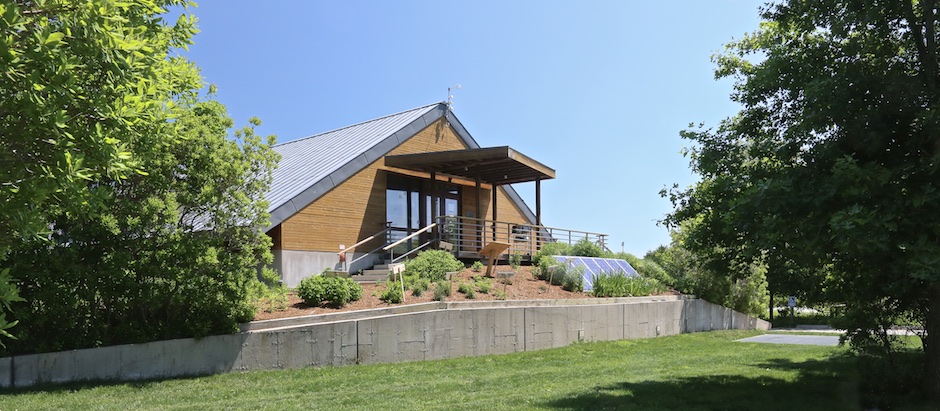
_______________________________________
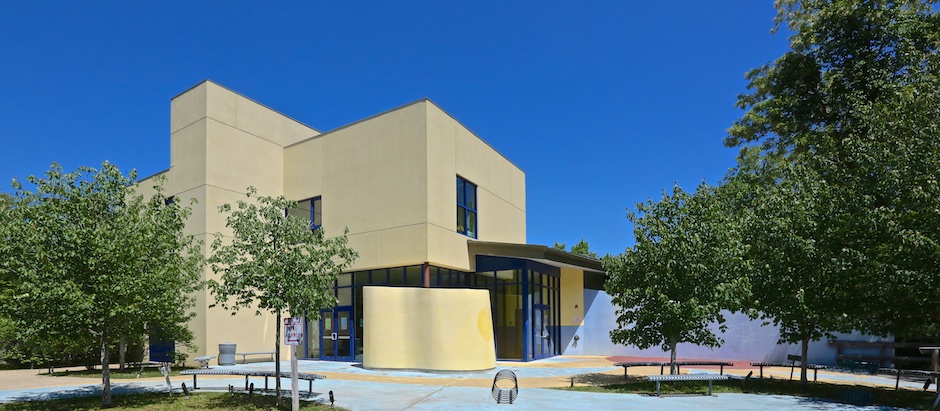
Children’s Museum of the East End (CMEE), 2005. Lee Skolnick Architecture + Design Partnership.
The Children’s Museum of the East End upholds its mission “to spark imagination and foster learning for children of all backgrounds and abilities and to build strong connections within the East End community by providing playful experiences” by presenting educational exhibits and programs and by partnering with other arts and social service organizations to address issues that concern families in the community. –— Children’s Museum of the East End.
_______________________________________
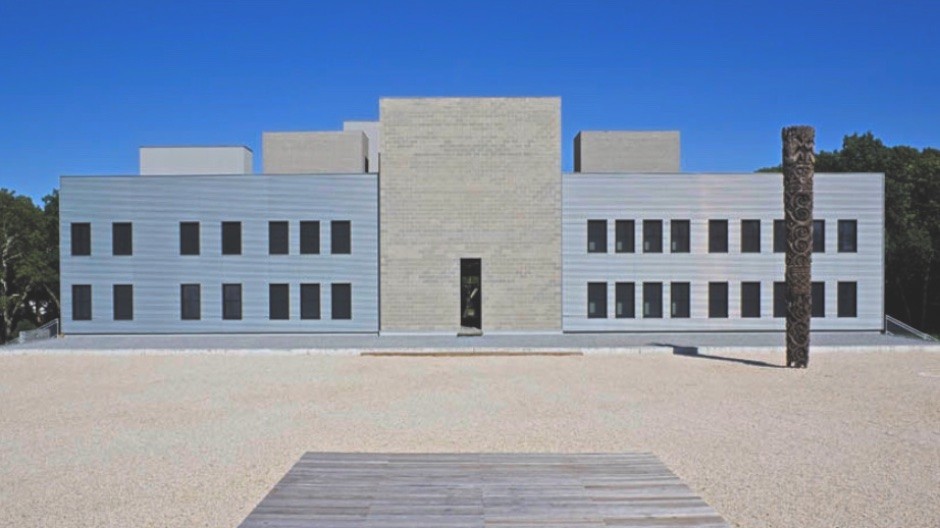
Watermill Center, 2006, Water Mill. Robert Wilson design coordinator.
The Center itself opened in 2006, following a lengthy construction process that began around 1992. Robert Wilson first began visiting the grounds in 1986, when it was an abandoned Western Union engineering facility. There were a number of architectural teams working on the structure and grounds, including Carsten Siebert-Daniel Barenboim (GER), Serge von Arx (Norway), Judith Haase (GER), and Stelle Lomont Rouhali (NY-Bridgehampton).
The grounds and building were designed by Robert Wilson with input from his many collaborators.
The Watermill Center is an interdisciplinary laboratory for the arts and humanities completed in 2006 on the Long Island site of a former Western Union communication research facility. Founded by theater and visual artist Robert Wilson as a place for young and emerging artists to work, learn, create, and grow with each other, Watermill integrates performing arts practice with resources from the humanities, research from the sciences, and inspiration from the visual arts. Watermill is unique within the global landscape of experimental theatrical performance, and regularly convenes the brightest minds from all disciplines to do, in Wilson’s words, “what no one else is doing.” — Watermill Center
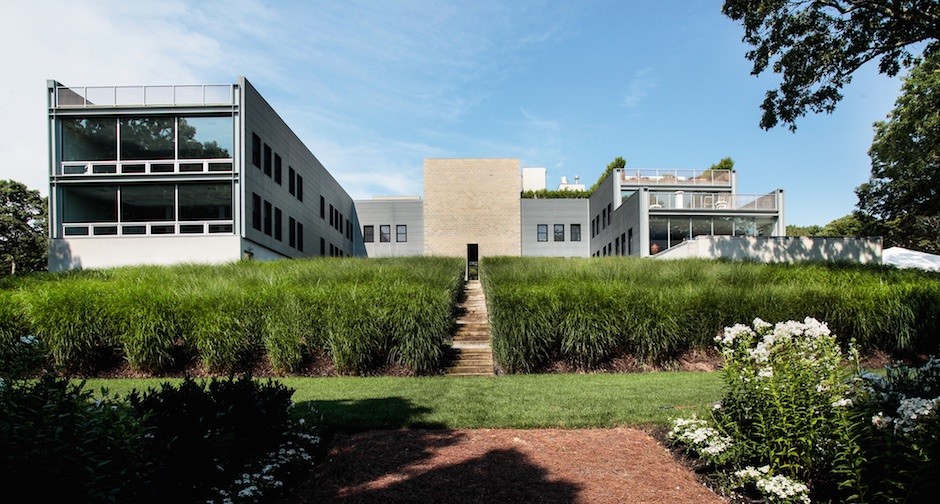
_______________________________________

The Bridge Clubhouse, 2007, Bridgehampton. Roger Ferris + Partners, architects. Sandpebble contractor.
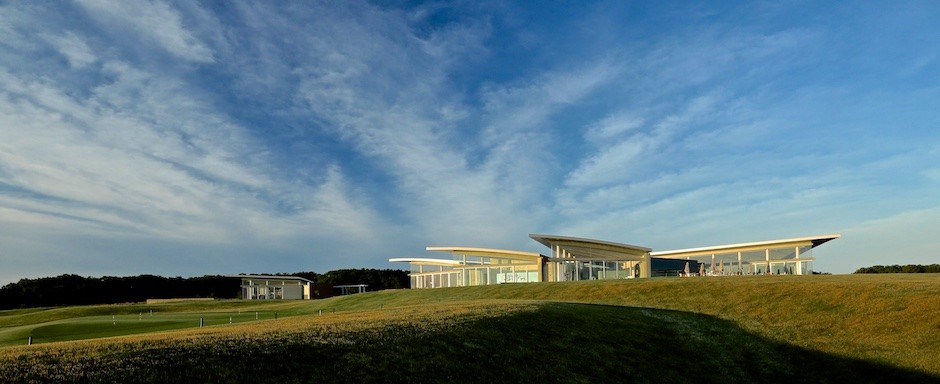
_______________________________________
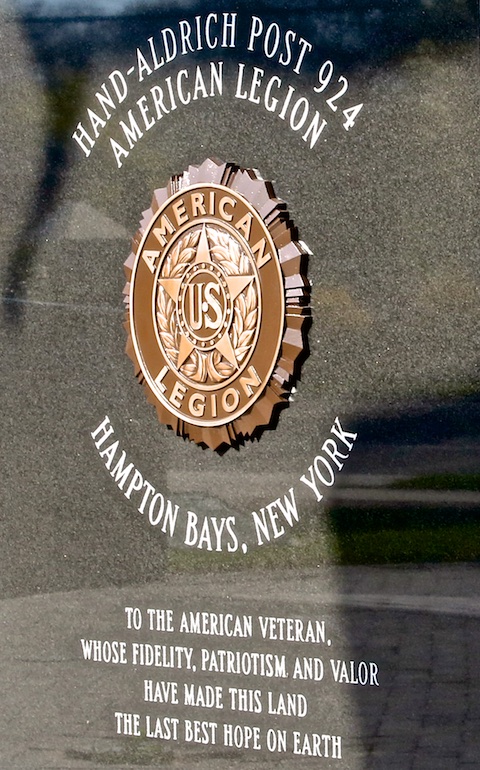
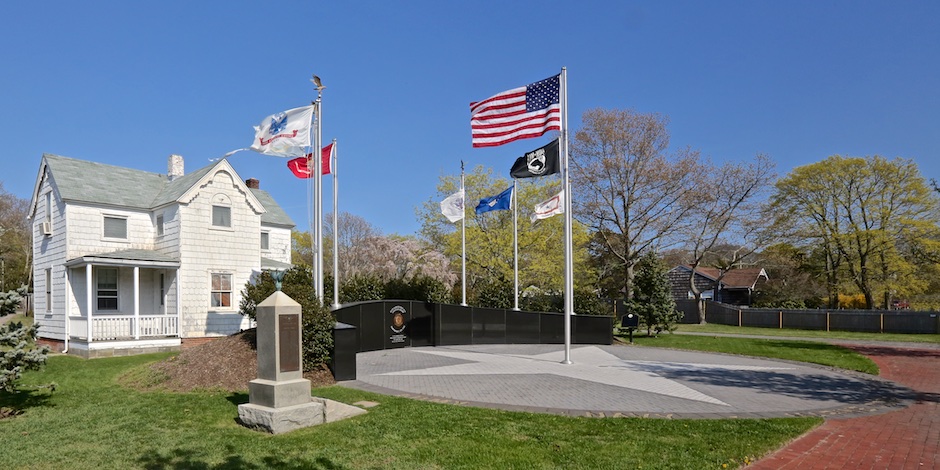
Memorial Dedicated May 26, 2008, Hand-Aldrich Post 924, American Legion, Hampton Bays. Tiedemann House, ca. 1900, in background.
_______________________________________

Oceanfront, 2008, Bridgehampton. Fleetwood & McMullen Architects. SDC Construction.
_______________________________________

Oceanfront, 2008, Bridgehampton. Stelle Lomont Rouhani Architects. Wright & Co. Construction.
——————————-
AAQ Resource: Stelle Lomont Rouhani Architects
_______________________________________

_______________________________________
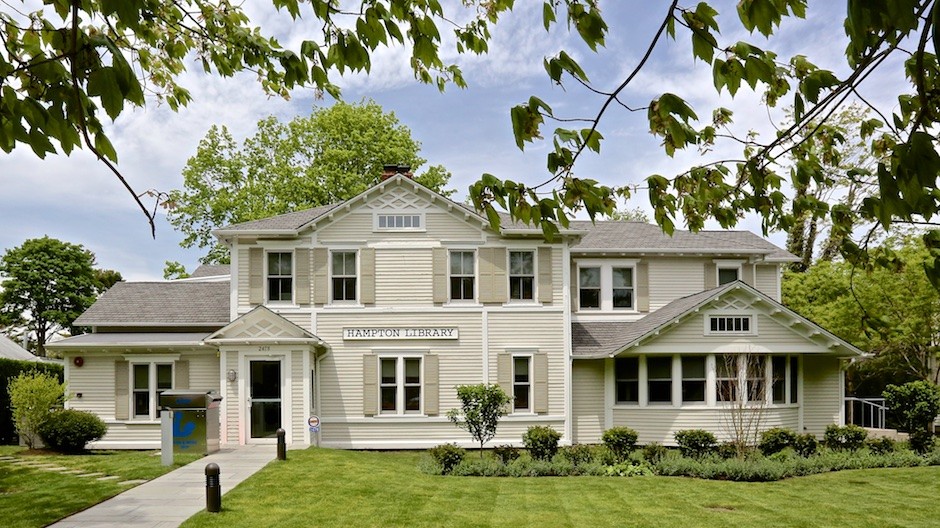
Hampton Library, Bridgehampton. Built 1877, second story 1898. Renovated & expanded in 2009 / Lee Harris Pomeroy Architects.
Founded in 1876, the one-story Hampton Library opened its doors in the spring of 1877. The railroad used the existence of the library as a draw for travelers to make the trip east. To that end, the Long Island Railroad shipped the lumber for its construction gratis. At the time, the library had the largest collection east of Brooklyn. It also had a printed catalog of the entire collection that could be purchased entities. Many boardinghouses bought the catalog for summer guests to peruse. Cottagers and boarders could join the library for one year for $1, or they could buy a part-year subscription: three months for 75 cents or two months for 50 cents. In 1898, the library raised its roof and added a second story, for the librarian’s housing. — Julie Greene, Bridgehampton’s Summer Colony, Images of America / Arcadia Publishing.
AAQ Resource / Education / Books — Click Here.

_______________________________________
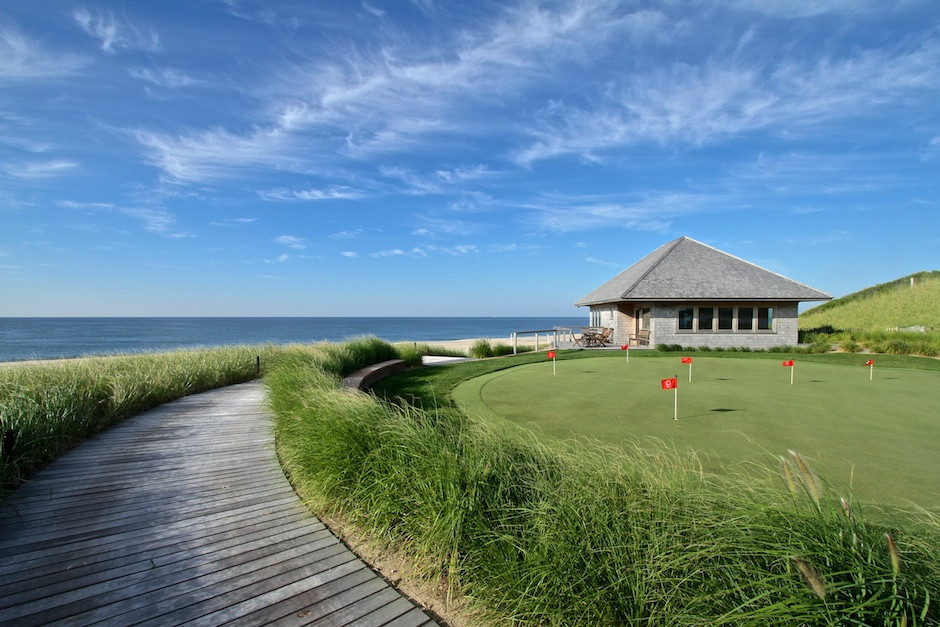
Oceanfront, 2010. Mark Matthews, Architect. George Lynch, Landscape Architect.
_______________________________________
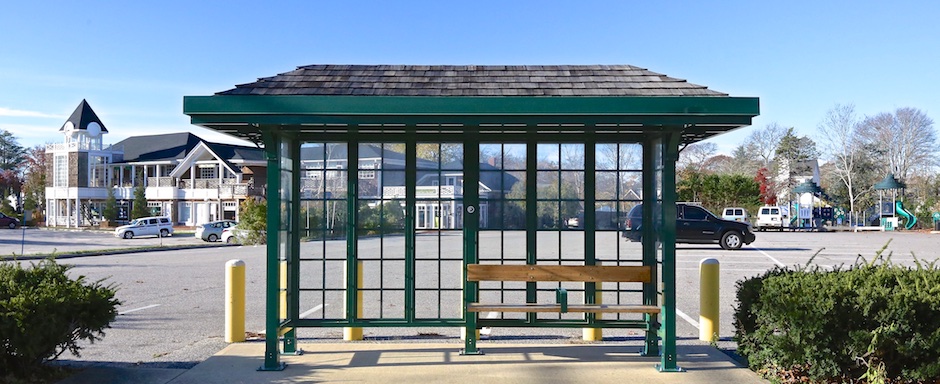
Bus Stop Shelter, Suffolk County Transit, Westhampton Beach
_______________________________________

Montaukett Learning Resource Center, 2010, Suffolk County Community College, Speonk. JCJ Architecture.
_______________________________________
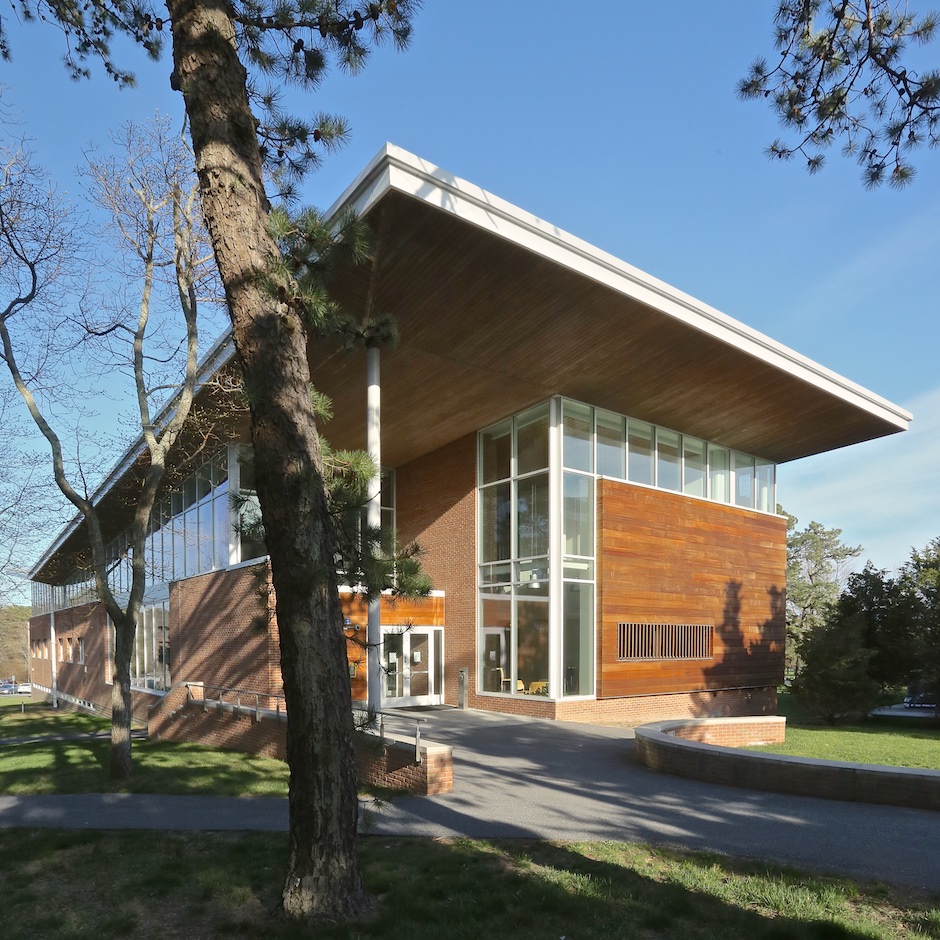
Southampton Library, Stony Brook Southampton Campus, 2011. Mitchell / Giurgola Architects. Loring Consulting Engineers.
_______________________________________
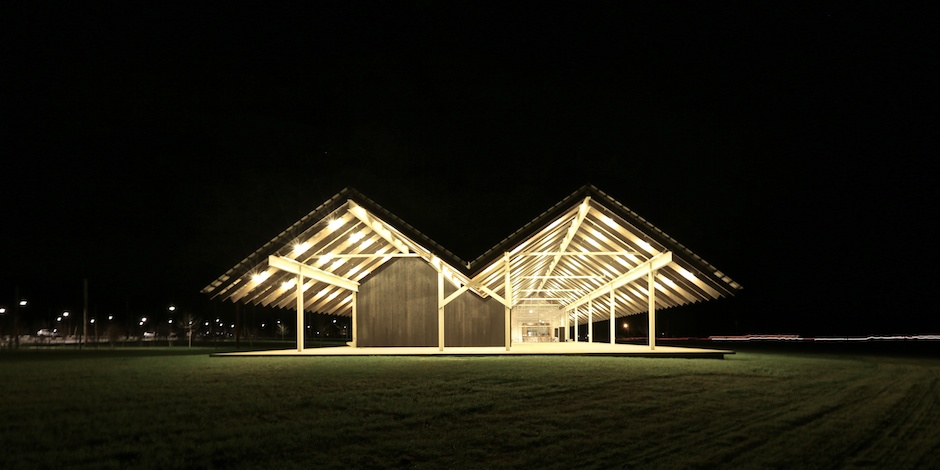
Parrish Art Museum, 2012, Water Mill. Herzog & de Meuron Architects. Reed Hilderbrand Associates, Landscape Architects.
Inspired by the natural setting and artistic life of Long Island’s East End, the Parrish Art Museum illuminates the creative process and how art and artists transform our experiences and understanding of the world and how we live in it. The Museum fosters connections among individuals, art, and artists through care and interpretation of the collection, presentation of exhibitions, publications, educational initiatives, programs, and artists-‐in residence. The Parrish is a center for cultural engagement, an inspiration and destination for the region, the nation, and the world. — Parrish Art Museum.
Visit AAQ’s Museum Architecture Section:
Parrish Art Museum / Herzog & de Meuron Architects, 2012
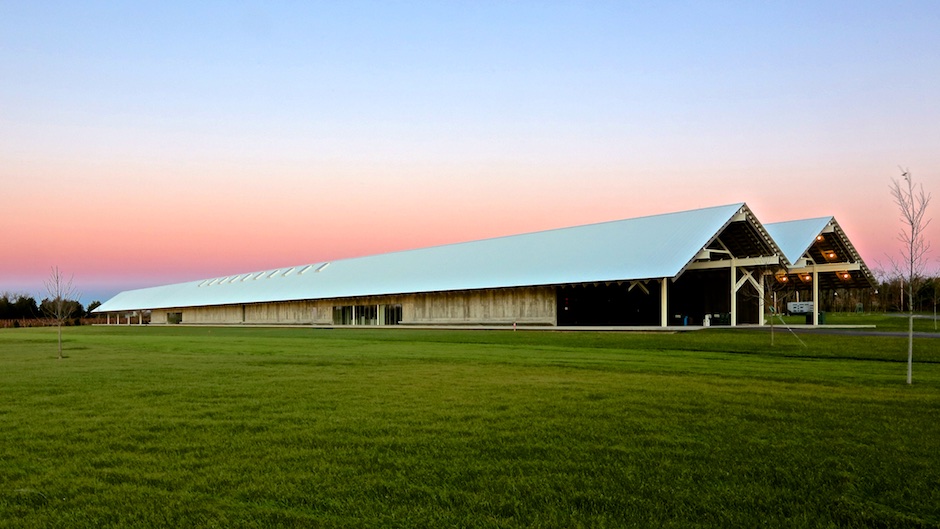
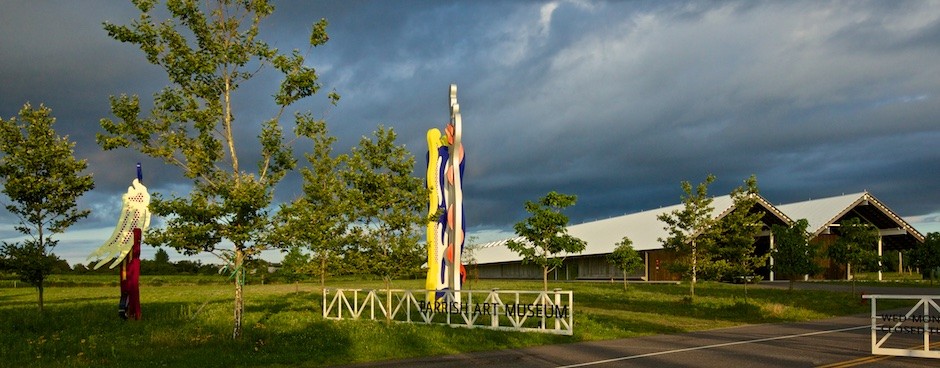
Roy Lichtenstein’s Tokyo Brushstroke I & II, installed April 16 & 17, 2014. Photo: August 14, 2014.

Parrish Art Museum wrap, 2015. Hampton Jitney, Southampton, founded 1974.
_______________________________________
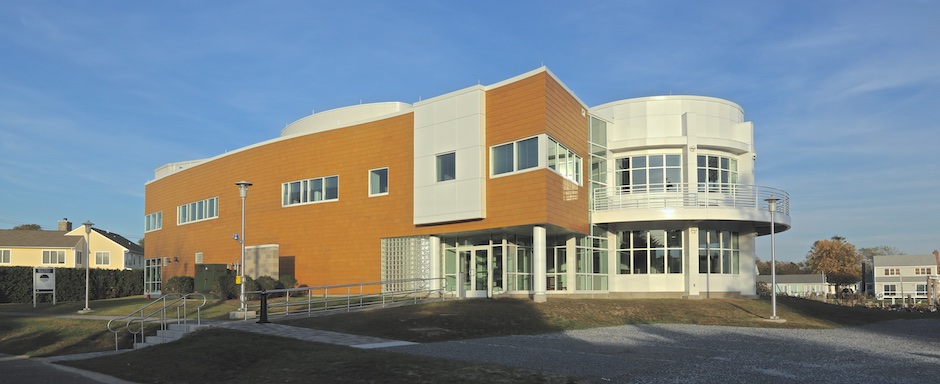
SoMAS: School of Marine and Atmospheric Sciences, Southampton, 2013. SLAM Collaborative, Architects. E.W. Howell, General Contractors.
The School of Marine and Atmospheric Sciences (SoMAS) at Stony Brook University is the State University of New York’s center for marine and atmospheric research, education, and public service. Currently, there are more than 500 undergraduate and graduate students and 90 faculty and staff from 16 different nations working together to better understand how our marine, terrestrial, and atmospheric environments function and are related to one another. Research at SoMAS explores solutions to a variety of issues facing the world today ranging from local problems affecting the area around Long Island to processes that are impacting the entire globe….The School’s core mission, principles and values provide the guideposts as the program navigates a world in which trends in scientific knowledge, technological innovation, pedagogical theory, budgets, socioeconomic factors and a myriad other factors intermesh to produce opportunities and constraints to achieving them. — School of Marine and Atmospheric Sciences (SoMAS).
_______________________________________

Greek Orthodox Church of the Hamptons, 2013. Sirio Tonelli, mosaic. Gilberto Lopez, Architect. West Rac Contracting. Landscape, Araiys Design.
Visit AAQ Resource / Landscape Architect — Araiys Design

_______________________________________
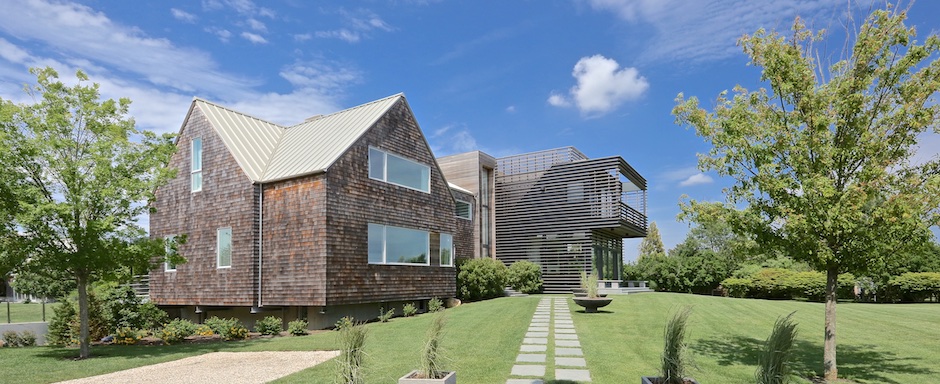
Sagaponack, 2015. Martin Architects.

_______________________________________
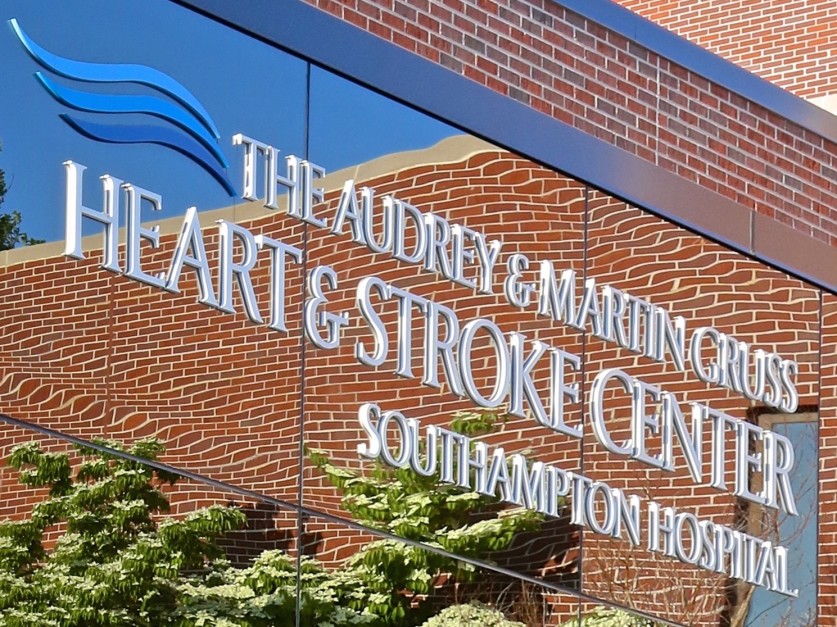
Audrey & Martin Gruss Heart & Stroke Center, Southampton Hospital, 2015. Victor Famulari, Architect, PC. EW Howell, General Contractors/Construction Managers.
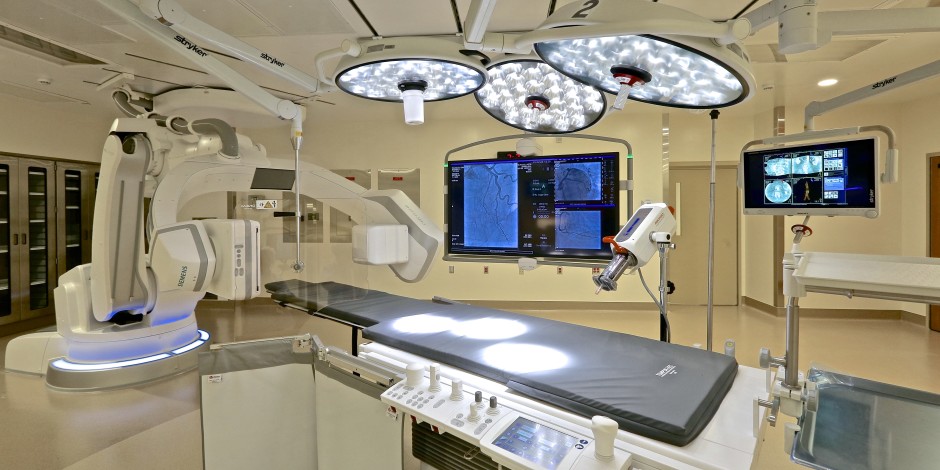
Operating Room, Audrey & Martin Gruss Heart & Stroke Center, Southampton Hospital
_______________________________________
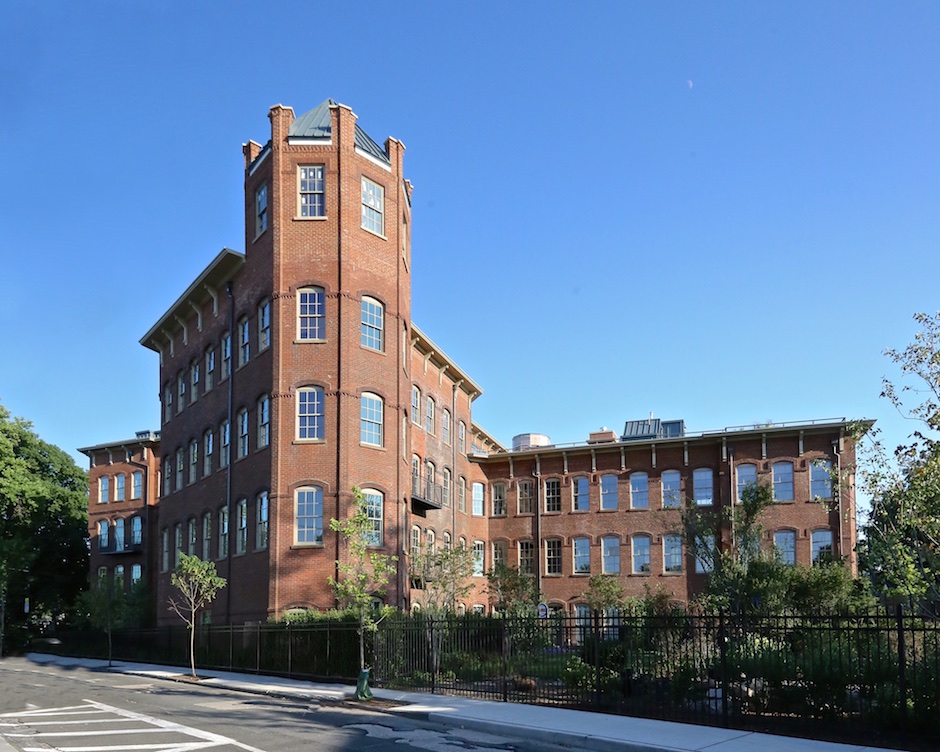
Watchcase, 2015, Sag Harbor. Restoration / Conversion to Condominiums — Design Architect: Beyer Blinder Belle Architects — Builder: Racanelli Construction Co. — Landscape Designer: Quennell Rothschild & Partners, LLP.
To See Archival Images of Original Structure — Fahys Watchcase Factory, 1880s visit:
Town of Southampton, 1866 — 1915 / Post-Civil War Prosperity & Immigration
Also, visit post in AAQ’s Construction / Restoration Section:
_______________________________________
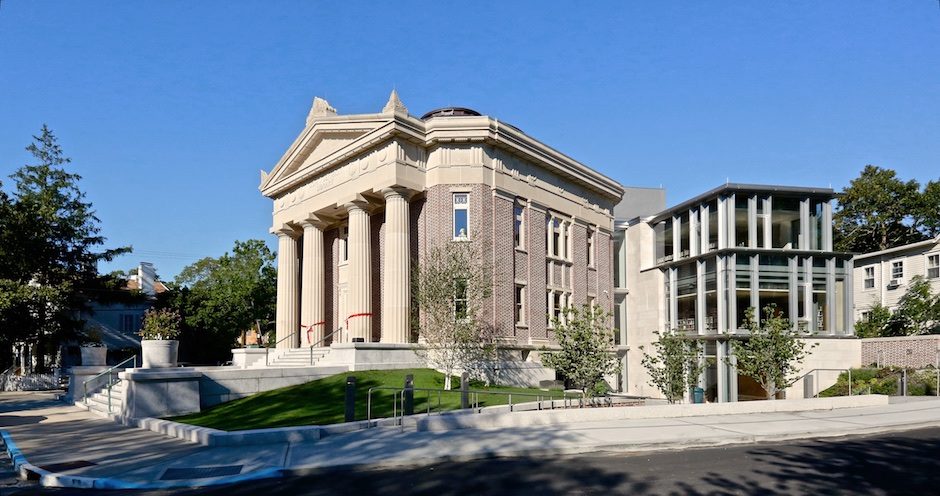
John Jermain Library, 2016, Sag Harbor. Newman Architects. Trunzo Building Contractors.
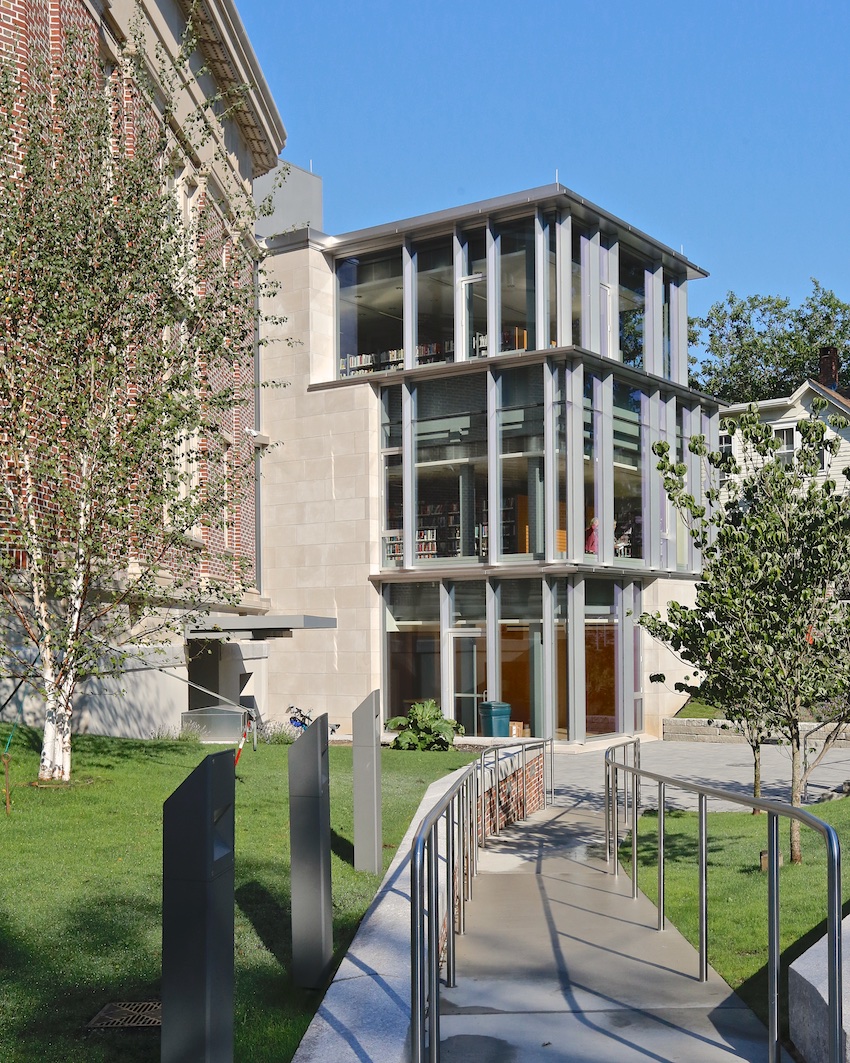
The John Jermain Library has been designated as an historic landmark by the Village of Sag Harbor, and is a contributing building within the National Register-listed Sag Harbor Historic District. The Library was commissioned and built by philanthropist Margaret Olivia Sage in memory of her grandfather, Major John Jermain, and presented by her as a gift to the people of Sag Harbor on October 10, 1910. The original building is 7,084 square feet. The three-story addition, including the lower level area dedicated to mechanicals, is 7,267 square feet.
The finished project includes:
· Restoration of the interior and exterior of historic building
· An elevator
· Fully Handicapped-accessible building
· Expanded space for children’s, teen and family services
· A climate-controlled archive for rare historic materials
· A new community room for programs and classes

_______________________________________
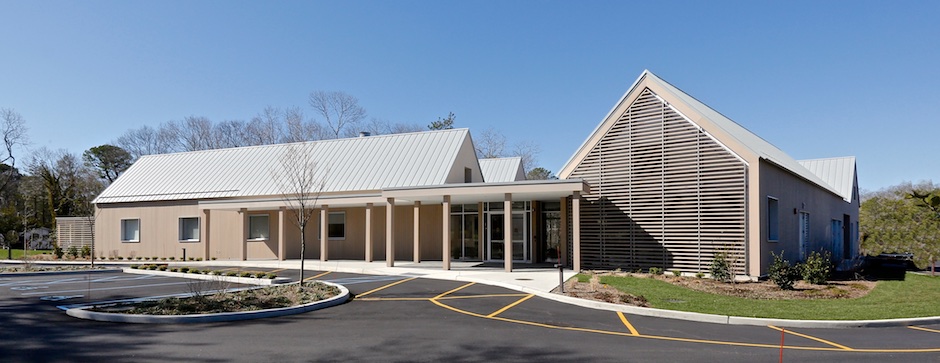
East End Hospice Inpatient Facility, Quiogue, 2017
The Building – Our Inpatient Facility has been designed as a freestanding medical facility with residential character and all necessary equipment to safely accommodate eight patients, the maximum amount allowed by New York State Department of Health regulations for hospice facilities. It has been constructed to conform to the rigorous Life Safety Codes.
Each patient has a private suite, equipped with medical equipment and oxygen to manage the complex needs of the critically ill while providing comfortable accommodations for patients and family members. The suite includes a sitting or transitional area for family to spend quiet time in private, a bathroom and bedroom as well as a terrace with a beautiful view of the water and access to the outdoors.
A full service nurses’ station with a view of each suite, a private nurses’ lounge, a spa room with soaking tub and grooming station, a private consultation room for meetings with physicians, counselors and families are critical pieces of the facility. A fully equipped kitchen and laundry are available for use by family and staff.
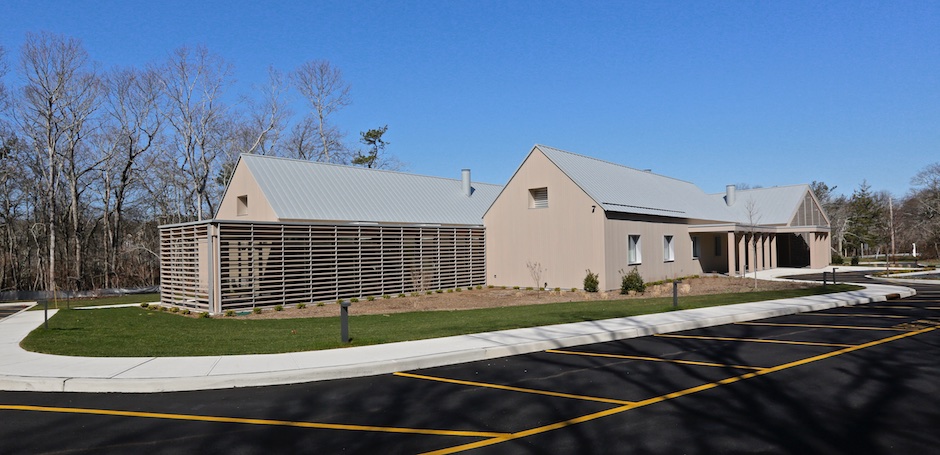
 Rendering courtesy of Roger Ferris + Partners.
Rendering courtesy of Roger Ferris + Partners.
Common areas, including a sunroom, library, and garden, as well as intimate gathering spaces for family and visitors are part of the design. The sunroom and library are set in a wing that wraps protectively around the patient wing – perfectly situated to capture light on the water and stunning East End sunsets. Skylights illuminate the main hallway.
Grounds of the six acre property will be affected as little as possible to preserve the character of this peaceful waterfront setting. Over 55% of the site will be placed in a conservation easement. The facility itself is designed to have meaningful sustainable initiatives.
Roger Ferris + Partners, Architects. Axis Construction. Araiys Design, Landscape Architecture.
www.eeh.org
_______________________________________

Dock off Long Wharf, July, 2015, Sag Harbor
_______________________________________
—————————— PUBLIC PROJECTS TO BE COMPLETED ————————–
——————————————-
________________________________________________________________________
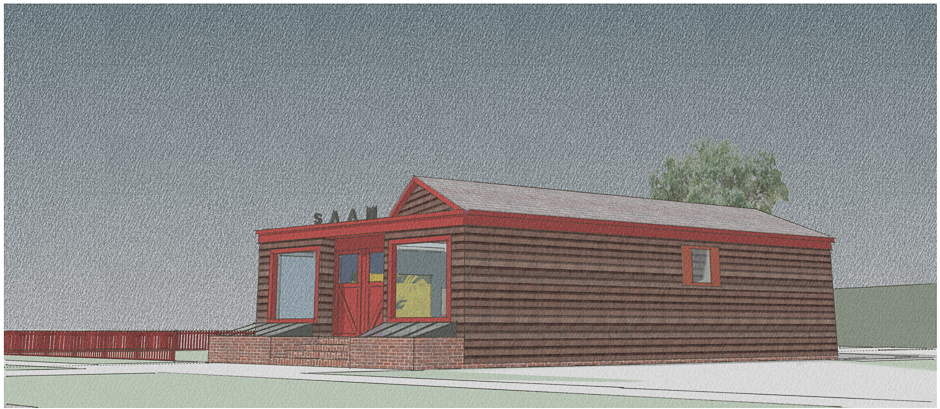

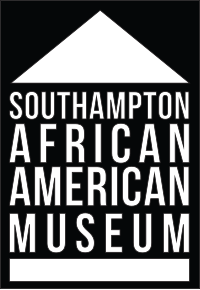 The African American Museum of the East End is conceived as a restoration and addition to an existing one-story frame building. The site is located in the Village of Southampton on North Sea Road Village entry corridor and Hillcrest Avenue intersection.
The African American Museum of the East End is conceived as a restoration and addition to an existing one-story frame building. The site is located in the Village of Southampton on North Sea Road Village entry corridor and Hillcrest Avenue intersection.
The two and a half story frame building will function as a community center and exhibition and research space documenting the life, history and trends of the east end African American community throughout its history, continuing to the present.
Capital Campaign in Process
Southampton African American Museum
www.southamptonafricanamericanmuseum.org
Siamek Samii, Architect. Renderings courtesy of the architect.

November 17, 2018
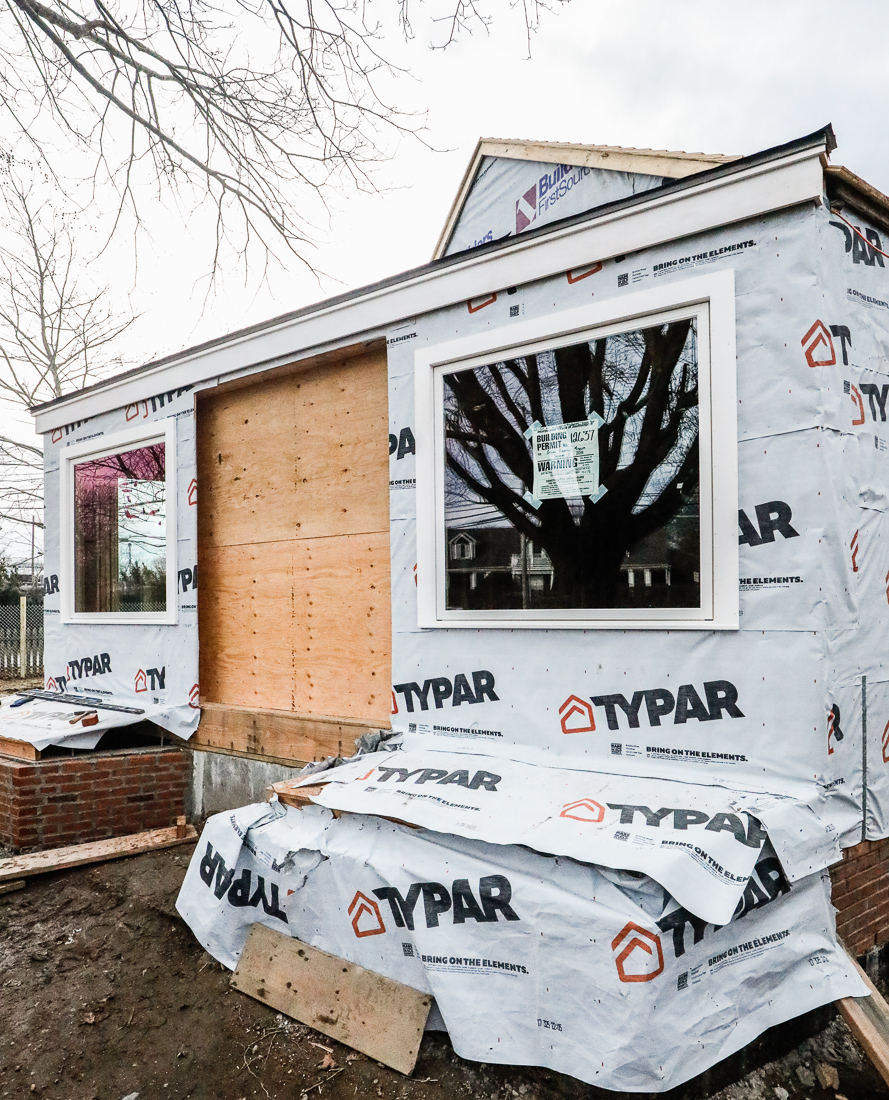
December 20, 2018
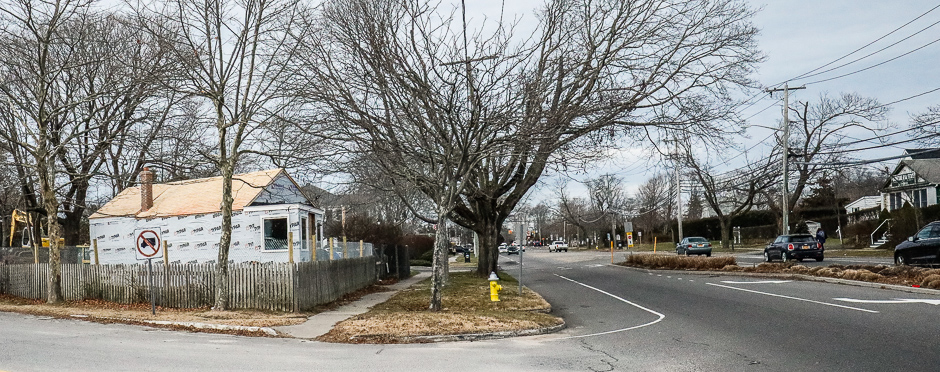
December 20, 2018
—————————————————————————————————

_______________________________________________
Art & Architecture Quarterly / East End thanks the following individuals and organizations that provided images & information in the preparation of these portfolios:
Mary Cummings, Archivist, Southampton Historical Museum for archival photos, postcards & information, and author of Southampton / Images of America Series / Arcadia Publishing.
Zach Studenroth, Town Historian, Historic Division, Southampton Town Clerk for Walking & Driving Tour Guides prepared in celebration of the Town of Southampton’s 375th Anniversary.
Julie Greene, Collections Manager/Curator/Archivist at the Bridghampton Historical Museum, and author of Bridgehampton’s Summer Colony / Images of America Series / Arcadia Publishing.
Sally Spanburgh, Chairperson of the Town of Southampton Landmarks and Historic Districts Board, and author of The Southampton Cottages of Gin Lane / The History Press
Anne Surchin, Houses of the Hamptons / Acanthus Press, co-authored with Gary Lawrance.
The Remsenburg Association, A History of Remsenburg
Town of Southampton / Historic Resources Survey Prepared by AKRF, 2014
Water Mill: Celebrating Community, A History of the Long Island Hamlet, 1644 / 1994
As well as, Stephanie Davis, Jean Held, Marsha Kenny, Leigh Phillips and Eric Woodward.
———————–
AAQ / Resource / Education, Books — Click Here.
Historic Division, Southampton Town Clerk
————————————————
Historical Organizations
Bridgehampton Historical Museum
Westhampton Beach Historical Society
As well as, the Town of Southampton and the Historic Division / Southampton Town Clerk.
————————————————-
All photographs, except archival photographs and postcards & Watermill Center exterior, copyright Jeff Heatley.
————————————————-
Visit these AAQ Portfolios:
Southampton Town, 1640 / 1776: Settlement & Colonial Periods
Southampton Town, 1777 / 1865: Early Republic & Economic Expansion
Southampton Town, 1866 / 1915: Post Civil War Prosperity & Immigration
______________________________________________


